Hey, I was in a podcast with Margaret Dunlap, Paul Cornell and John Scalzi (edited by Dave Probert from Geek Planet Online)! You can listen to us chat about what we do over on the Cornell Collective website. 
Viewing: Blog Posts Tagged with: pictures_mean_business, Most Recent at Top [Help]
Results 1 - 19 of 19
Blog: Sarah McIntyre (Login to Add to MyJacketFlap)
JacketFlap tags: pictures_mean_business, podcast, interviews, Add a tag
Blog: Sarah McIntyre (Login to Add to MyJacketFlap)
JacketFlap tags: pictures_mean_business, Add a tag
Big thanks to Alastair Horne for running this #PicturesMeanBusiness interview on Publishing Perspectives: 
You can follow Alastair on Twitter at @pressfuturist, and @pubperspectives. Big thanks to Declan Shalvey, over in the USA, who's been doing similar work for the #ArtCred campaign. If you're at New York Comic Con, be sure to support the talk he's giving. (@declanshalvey on Twitter.) 
You can read more about the #PicturesMeanBusiness campaign at picturesmeanbusiness.com.
Blog: Sarah McIntyre (Login to Add to MyJacketFlap)
JacketFlap tags: pictures_mean_business, awards, Add a tag

I was chuffed to get a call from journalist Tom Tivnan, that The Bookseller had put me up for their Rising Stars gallery, for my work on the #PicturesMeanBusiness campaign. It's nice to be recognised, but even better, it's great to see The Bookseller championing a campaign that was initially critical of them. They took the criticism in a thoughtful, professional way, made changes to the way they credited illustrators, and they're now real champions of the cause. Thank you, Tom, Fiona Noble, Philip Jones, Charlotte Eyre, Sarah Shaffi, Natasha Onwuemezi, Kiera O'Brien, FutureBook's Porter Anderson and everyone who have been working hard to credit illustrators and encouraging other people to do so, too. We're definitely making progress and seeing more illustrator names on front book covers and illustrators mentions in the media (including in The Bookseller).
While I don't think it's really a one-person campaign - it takes lots of people to make a difference - The Bookseller are leading the way and I'm very grateful to them for that. Article by Tom Tivnan ('cos #JournalismMeanBusiness):
I've highlighted the bits I think are the most important, and I can only do this campaigning because of the support I've had from my co-author Philip Reeve, Liz Cross and our publisher OUP, my agent Jodie Hodges, Joy Court of the Carnegie-Greenaway committee, the Society of Authors (Nicola Solomon, Niall Slater, Jo McCrum), Andre Breedt and the data team at Nielsen, Kellie Barnfield and Helen Graham at Little Brown for their help with data, Kate Wilson for starting up the Illustrator Salons, and all the writers, illustrators, bloggers, reviewers, booksellers and people in publishing who have been looking out to see illustrators credited properly and professionally.
A lot of illustrators are still frightened of looking like 'trouble' to speak out, but from what they say to me in private, I know your help will be hugely appreciated. Working as a freelance illustrator is a scary job, especially if you don't have a working partner or family who can look after you when your pay is uneven. I've been lucky that my partner works and it's given me some more freedom to trying to make the profession a bit more accessible to single people and people from poorer backgrounds. #PicturesMeanBusiness won't solve all the problems facing illustrators, but we need to fix the industry one step at a time: if illustrators don't have to lose brand-name recognition and the resulting loss of business because the industry, media and society at large are crediting them properly, we can focus our energies elsewhere, trying to make a living and making better books. And publishers will win in so many ways, including better searchability for their books in metadata, being able to grow their illustrators as brands that people want to search out and buy, and by gaining illustrator loyalty.
You can read more in this article by Tom Tivnan and Tom Holman, and find out about the other Rising Stars here. And, of course, find out about Pictures Mean Business at PicturesMeanBusiness.com. Do spread the word about the campaign!
Blog: Sarah McIntyre (Login to Add to MyJacketFlap)
JacketFlap tags: portrait, pictures_mean_business, Add a tag
If you're in Scotland, look out for a copy of today's Herald, I have an article in it! You can also read it online here: 
Yesterday's #PortraitChallenge got me fired up to do some more pictures with actual paint. I've been doing a lot of digital work, and sometimes digital works best for me, but then I miss working with real paper in front of me the whole time. Here's a not-very-accurate self portrait, painted in watercolour, and when it was just pencil linework. 

Blog: Sarah McIntyre (Login to Add to MyJacketFlap)
JacketFlap tags: portraits, conference, pictures_mean_business, Add a tag
I got to draw a lot of portraits on Monday! I was at a London conference called Author Day, hosted by The Bookseller magazine, representing the #PicturesMeanBusiness campaign to get illustrators properly credited for their work. So it only made sense to bring in some pictures. 
Hope you enjoy them! I didn't draw all the speakers - there wasn't enough time - but I managed to capture a few. Here's book vlogger Leena Norms: 
Some of the best news I heard all day came from The Society of Authors' Nicola Solomon. She'd visited Amazon and had a chat with them about why illustrators and translators keep getting left out of book listings. And it turns out that a lot of publishers don't realise that when they're filling in data, there's a drop-down menu to fill in names of illustrators and translators, too. So it's a problem with publisher data entry. Nicola and I are thinking we'd like to create a short photo tutorial for publishers, so they can teach staff how to enter their data to include everyone. This might mean some progress! Illustrators I know so often have to chase people for months to try to get this fixed. 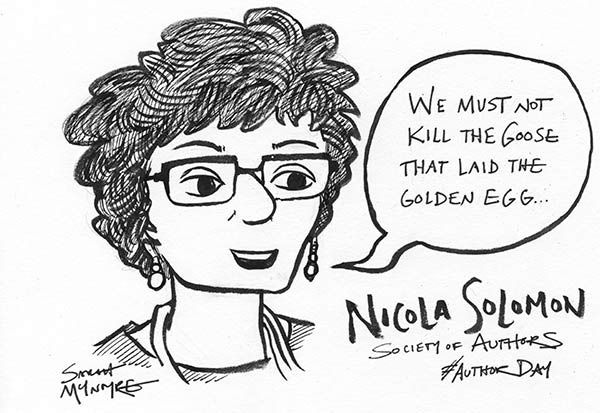

Editor of The Bookseller Philip Jones:

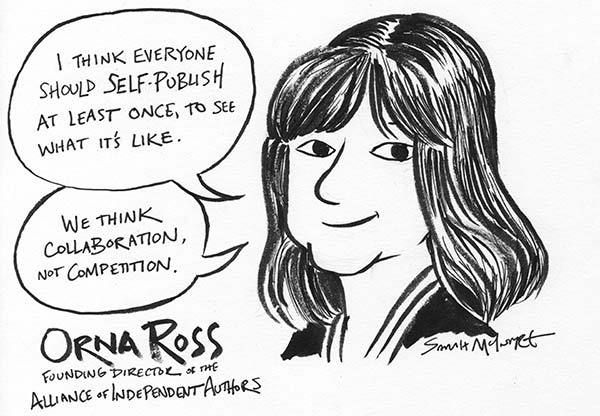


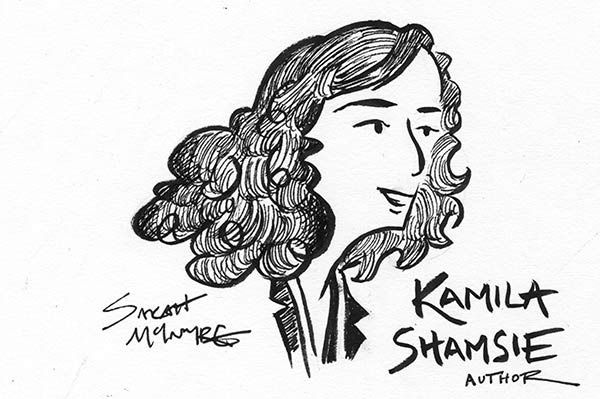


And here's Porter Anderson from Future Book, who programmed and organised the conference from Florida and came in to host it on the day. Thanks, Porter!

I didn't get to draw translator Louise Lalaurie, who'd flown in from France, because were were on the same panel together. But it was great connecting with her and showing publicly that translators and illustrators are standing together to say that, besides being fair and supportive, there are good business incentives for publishers to give proper credits. (Check out the parallel translator Twitter campaign at #NametheTranslator)
Great to meet everyone, and I wish I'd been able to have longer chats with more people! Some really good stuff covered, and look out for longer blog #AuthorDay posts and articles about everything that went on! 
You can find out more about Pictures Mean Business on the website and follow the discussion on Twitter at #PicturesMeanBusiness. Here's a sheet I printed out very late the night before and handed out, which sums up what people can do to help: 

Blog: Sarah McIntyre (Login to Add to MyJacketFlap)
JacketFlap tags: pictures_mean_business, Add a tag
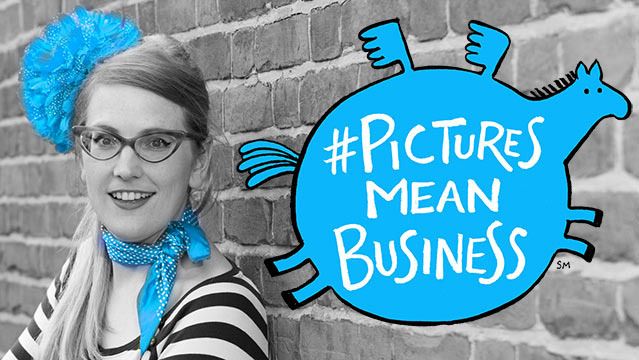
Original full-colour photo by Dave Warren
Hey, I've written an article I wrote about the #PicturesMeanBusiness campaign for the Independent Publishers Guild: How Metadata can Make or Break Illustrators, and feel free to share! (Here's their article Twitter link.)
Blog: Sarah McIntyre (Login to Add to MyJacketFlap)
JacketFlap tags: pictures_mean_business, Add a tag
Literary agents! Illustration agents! We need your help!
Sales of illustrated chapter books are booming - David Walliams' and Tony Ross's illustrated novel is at the top of the overall UK sales chart today - but many illustrators are getting cut out of almost all career-advancing publicity. 
One of the main reasons is that illustrators (particularly of illustrated fiction, or so-called 'chapter books' or 'middle grade books') aren't getting their names on the front covers of their books. While they're often credited on the back cover or inside the book, it's the front cover that does the publicity rounds, and what readers and reviewers use to judge who created it. If the illustrator's name isn't on the front cover, they're far less likely to get proper recognition in metadata, so their books won't be searchable online. They may get left out of award lists. Their names may not be included at all in Advance Information sheets sent to reviewers (as noted by Fiona Noble at The Bookseller*).
Here's where we need your help! What need you to unite in your efforts to make sure that in contracts, illustrators get a guarantee that their names will be on the front covers of the books they illustrate. My guideline has been any book that has at least one illustration per chapter. In the #PicturesMeanBusiness campaign, we're not asking for a lot - not even total equality with the writer in front-cover billing - just that there BE a billing. If the publisher wants to put the illustrator's name in smaller font, that's okay, as long as it's visible on the front cover.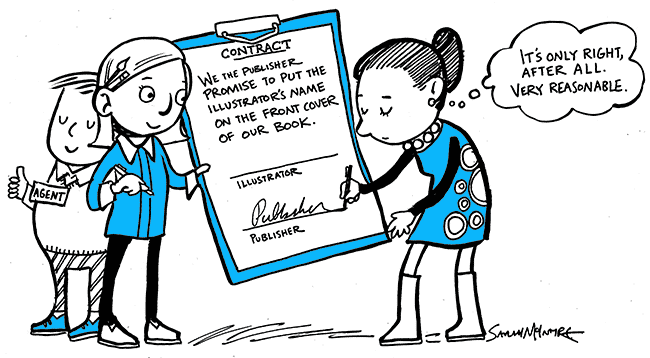
We need your help in this because illustrators are afraid; we worry that if we make too much of a fuss, we'll be branded as 'trouble' and the publishers will commission from work from illustrators who don't stand up for themselves. I'm only able to argue the case because I have such solid support from my own agent Jodie Hodges, publishers, series co-author Philip Reeve, and his agent Philippa Milnes-Smith. 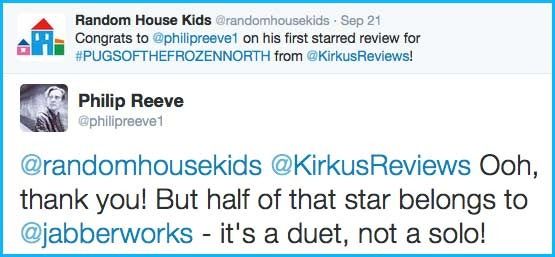
Publishers may offer to pay illustrators an extra fee, so they don't have to put their names on the front covers, but this isn't good enough. Why are publishers ashamed to admit their books are illustrated? Illustration is a key selling point, and not showing the book is illustrated inside is missing a key marketing angle. Pretending that the writer did the pictures (in the name of single-name branding) is false advertising. Illustrators work freelance just like writers - we don't get salaries or benefits - and illustrators need to build careers based on our names. 

When publishers say there's no room on the cover for the illustrator's name, this is rubbish. Foreign editions often rejig the cover so this isn't a problem, such as my Dutch publisher, who have completely taken the #PicturesMeanBusiness campaign on board: 
Without a front-cover credit, illustrators are always going to be left out. We need you to urge publishers to be leaders in doing the right thing, not the last publishers to follow, kicking and screaming. Illustrators are watching how publishers respond, and the publishers who continue to put up the most resistance may find they have trouble commissioning work from the best illustrators. We need you as agents to keep an eye on publisher practice, too.

If your illustrator is working with a celebrity writer, don't let the publisher tell you that it's common practice for all celebs to have single billing. This certainly is not the case with picture books, as seen by examples here. (All these covers credit their illustrators.) Celebs are usually much more quick to recognise artistic skill than some publishers, I find, and are pleased (not ashamed) to be paired up with an artist working in a different field to their own. 
If you can tweet your support with the #PicturesMeanBusiness hash tag, we can get a good idea of which agents are supportive and WILL stand up for their illustrators. Even if you don't tweet, we ask that you'll join us in making sure your clients don't get any nasty surprises when their book comes out, uncredited. We need you agents to lead the way, even for illustrators who don't have agents. We need to make the deliberate omission of illustrators something that everyone finds distasteful. 
The great thing about this campaign is that, in public, almost everyone agrees with it and supports us fully. It's kind of a no-brainer. But we still need your brains and your clout. Recent sales of physical books show that people are very interested in how books look, their craftsmanship, their tactile qualities. Illustrated chapter books are filling a big niche in the children's book market, in that under-filled gap between picture books and text-only books; it's just the gap where we're losing kids who will turn into readers for life, and pictures really help keep those kids on board. Interest in illustrated books for adults and comics/graphic novels is on the rise. Britain isn't a major manufacturing nation anymore, but illustration is one thing we can be proud to say that we create and export, and we do it very well.
Find out more about the campaign on the website www.picturesmeanbusiness.com and in the Twitter conversation at #PicturesMeanBusiness. 
*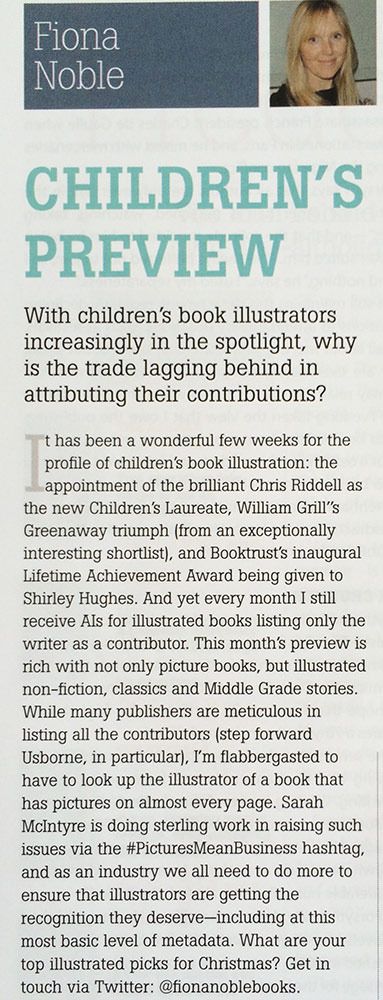
Blog: Sarah McIntyre (Login to Add to MyJacketFlap)
JacketFlap tags: awards, pictures_mean_business, Add a tag
This week I haven't had much chance to keep an eye on the latest #PicturesMeanBusiness campaign developments, but thankfully people have still been talking about it!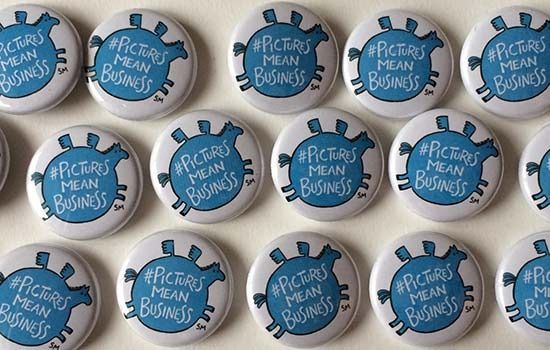
I've been traveling around the country on the #PugsRoadshow tour with a relay team of Oxford University Press publicists and my Pugs of the Frozen North co-author, Philip Reeve. I thought there would be time to blog on tour, but it's been FULL-ON stage shows to thousands of kids and I've only managed to crash into bed at night, getting up early for the next morning school event. 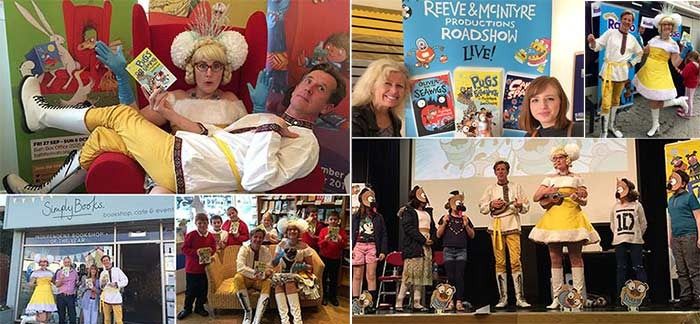
On Tuesday, I'd been invited to a London reception for The Hospital Club 100 Awards, but I couldn't manage to get away from the tour to go, and since there were lots of big names on the shortlist, I was pretty sure I wouldn't win. So I was very surprised to get a tweet from @TheHospitalClub saying I had indeed won the award, which honoured the work done to promote the #PicturesMeanBusiness campaign, followed by Sarah Shaffi's article in The Bookseller. 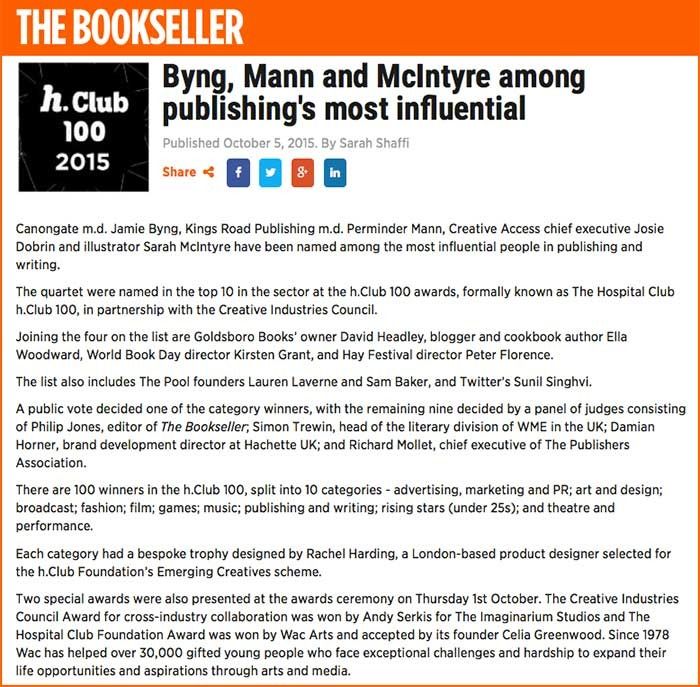
To be honest, I didn't quite get it; there are a lot of managing directors and people who are a lot more powerful in publishing than me; I'm pretty small-fry. So I looked into the award a bit more, and watched a video of the judges talking about what kind of people they were looking for in granting the awards:
* Somebody who doesn’t start a sentence with ‘The problem about publishing is…’ but they look at the challenges and the opportunities. - Simon Trewin
* Somebody who is making a mark and accelerating change. - Damian Horner
* What we are looking for in a winner is somebody who is challenging publishing and the wider book business. - Philip Jones
And I guess that's it, I have been trying to bring about change in a positive way: I know people in publishing care about illustrators and want to better for them, they just haven't realised how. At first I felt kind of embarrassed even to retweet the news, because I don't claim to be a major force in publishing, and I know lots of people have been trying for a long time to get illustrators better credited for their work. But here's why I think this year's been good timing for a campaign:
* Publishers are plugged into Twitter and illustrators can make it work for us. There's been a lot of attention concentrated around the Twitter hashtag #PicturesMeanBusiness because it's pulled the conversation together; people have been able to use it as a reference point without having to explain the whole argument each time: 
* The digital age means pictures are more important than ever. Another reason I think the campaign has gained ground is because so much of what people read now is on the Internet, and the Internet is SO driven by images, and the sharing of images. Tweets that have images attached to them often travel much further than words-only tweets. Sites such as BuzzFeed know they need to break up their articles with images to make them go viral. Last year everyone thought the book was going to be dead soon because of ebooks, but instead we've seen growth in illustrated children's books and in luxury editions that people buy as beautifully designed objects; readers love the visual and tactile aspects of their books and they often want more than generic-looking words on a screen. Publishers are realising more and more that children want illustrated chapter books to fill the huge gap between picture books and text-only books. They're used to reading stories with pictures on many platforms (just like their parents, who share Facebook pictures) and ripping them suddenly away from illustrated stories can turn them off to reading entirely.
* Craft and making things is a huge force right now in publishing. People don't just want recipe books, they want to know about people who make the food. People like the idea of things being created by identifiable people; thus the rise in celebrity chefs and shows like Great British Bake Off. Readers and viewers like to connect with people who make things, and people find illustration a heartwarming concept. Colouring books are huge right now, lots of people want to play a part in creating images.
So the campaign is timely; it's impossible these days to argue that illustrations and cover designs aren't part of what make books sell. And freelance illustrators (and photographers) know they need to build their names as brands to establish their careers; these pictures don't create themselves.
Some advances we've seen this year:
* More publishers seem to be including illustrators' names on the front covers of highly illustrated books. 
I don't have any concrete statistics about how many of these decisions were made because publishers were aware of the campaign, but from what I hear, it seems to be helping. I've had several e-mails from illustrators who hadn't previously been credited on covers, saying that because of the campaign, their publishers had reconsidered and are now going to give them a front cover credit.
* I've seen some growing expectation that celebrity writers will credit their illustrators when talking about their books to the media. 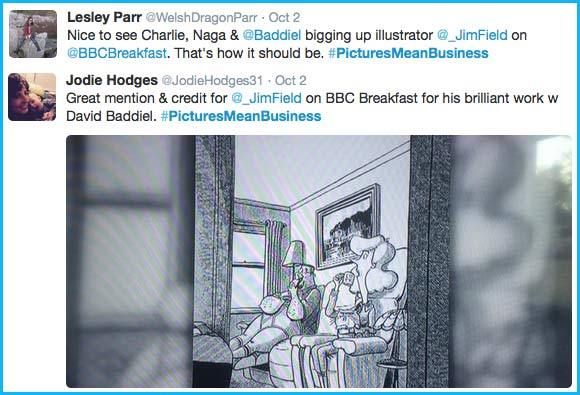
* Some illustrators seem to be realising that they need to speak up for themselves, and the hashtag gives weight to what they're saying. Hopefully agents are also more aware and are helping illustrators negotiate better contracts that don't leave cover credits and other crediting to the whim of marketing people near publishing time.
But we still face stiff challenges. I've had a lot of e-mails, direct messages and conversations with illustrators who are too scared to tweet using #PicturesMeanBusiness when an issue arises affecting their own books and branding, but who feel very strongly about the issue. They're afraid that they won't get more work if they try to negotiate a better deal for themselves or point out a failure in crediting, and they worry they'll be branded 'trouble'. By having a campaign, we're able to defend each other to a certain extent, so each person doesn't have to fight alone.
But the problem with a campaign is that it inevitably involves pointing out where people are doing something wrong, so the wrong can be made right. Even though almost everyone agrees with the campaign, I've annoyed several people rather badly by pointing out places where they should have credited illustrators. I do worry it will affect my own career, but I've had a sort of safety blanket because I work with Philip Reeve, who's an incredibly supportive co-author:
And my publishers - Oxford University Press Children's, Scholastic UK and David Fickling Books - all care about their illustrators and agree with the campaign. So I really owe it to them, that I haven't, like so many other illustrators, felt afraid I'd be risking my whole career to say anything.
Touring as an illustrator (and co-author) with Philip this week on the Pugs Roadshow has really shown me the power of images with kids; so many of them connect with our event when they get a chance to draw, and see us drawing. To pretend that Philip created the whole book and to ignore its many pictures would just be silly and miss a real chance to inspire them. The audiences are able to see that the pictures in the books they hold in their hands are created by a real person and connect with the story through the illustrations as well as through the words. 
In his interview about The Hospital Club 100 Award, judge Simon Trewin made this point:
A lot is talked about what is going wrong with publishing at the moment. I think what is exciting about publishing is an opportunity for readers to develop a direct connection with people writing books. Whether it’s through blogs or vlogs, we have a direct connection now, and direct connections, in my experience, stimulate sales.
I agree, and with my #PicturesMeanBusiness badge on, I'd say that letting readers have direct connections with illustrators is a crucial part of interesting them in the book and making them want to read more. Creating enthusiastic readers is in everyone's interest, not just those of illustrators.
Thanks very much to The Hospital Club for the award, and the chance to spread the news further about #PicturesMeanBusiness!
Find out more at www.picturesmeanbusiness.com. (And here's the whole judges' video if you want to watch.)
Blog: Sarah McIntyre (Login to Add to MyJacketFlap)
JacketFlap tags: pictures_mean_business, illustrator_salon, Add a tag
Last night my studio mate Elissa Elwick and I went straight from the studio to the first in a new series of Illustrator Salon events, featuring illustrator, animator and writer Steven Lenton being interviewed by Nosy Crow publisher Kate Wilson. Here's a little drawing I made of them:
And here you can see some of the books Steven's illustrated for Nosy Crow! We've recently seen some great picture books by people who come from an animation background, such as Benji Davies, Jon Klassen, Jim Field and Jonny Duddle. (Can anyone help me add some female animators to that list?) 
Steven talked about character design being his key element in setting up a story, and you can see some of his canine personalities here: 
Like most animators and illustrators I know, Steven mentioned his huge love of early Disney artist Mary Blair's artwork. ...Ha ha, I was just writing this blog post and mentioned that to Elissa, and she turned around with two Mary Blair books in hand: 
I'd previously heard a talk by Jon Klassen, who much prefers settings and backgrounds, and finds the characters the hardest thing to come up with, so it was interesting to hear that Steven's the oppositive. But both love shape over line, and try to get rid of a lot of their line work (outlines) in their final art, even if they use a lot of lines in their rough sketches. Steven and Kate both talked about the benefits of working digitally; how it gets rid of the cost and time involved in having to get artwork scanned. I can imagine the Photoshop layers also make the artwork much easier to convert into moving parts for apps. But when Kate asked him about some of his favourite illustrators, he mentioned David Roberts, who works with real pens and paint and submits his artwork to be scanned. Steven said that if he ever gets in a rut, he might spent a couple months working on getting away from digital artwork and using more traditional materials.
I know what he means, I keep thinking I could try to rely less on line (I'm so attached to using lines!), but I'd need some time to explore that way of working before launching straight into a book with it. And I've just downloaded loads of amazing Photoshop digital brushes from Kyle T. Webster but the trick is going to be getting time to learn how they work. Steven talked about spending a lot of time promoting his books, and having big ideas but not always the budget. I've been seeing him loads on the festival circuit, usually with his fab writer co-author Tracey Corderoy. Here's a photo I took of them and their custom-designed friends at Edinburgh Book Festival this year:
It was great to see lots of familiar faces in the audience, including a gang of us who are all represented by Jodie Hodges at United Agents (@JodieHodges31 on Twitter): Karl Newson (who's just recently signed on and check out his work; it's amazing, @Karlwheel), Elissa Elwick (@ElissaElwick), my amazing Jampires co-author David O'Connell (@davidoconnell) and me! 
I really appreciate Kate and editor Tom Bonnick at Nosy Crow responding to the #PicturesMeanBusiness campaign to credit illustrators by profiling them in this way. They're going to ask lots of illustrators to speak, not just Nosy Crow illustrators, and keep an eye out on the Nosy Crow blog and Kate's Twitter (@NosyCrow for future events. I really liked the venue, too - The Book Club in Shoreditch - funny lightbulbs stuck to the ceiling like we were in some sort of wasps' nest, and a good range of drinks and cocktails. I think my only suggestion for future events would be to offer name tags at the door, and encourage people to write their Twitter names as well. Elissa, Dave and I went for pizza afterward and as we talked over who'd been there, I kept having the awful realisation that I'd met loads of people I knew fairly well from Twitter and would've loved to have talked with longer, but never managed on the night to figure out who they were in person. ARGHH. 
Thanks for a great evening, Kate, Tom, Steven, the bartender, and everyone who made it so much fun! I'm really looking forward to the next one. You can follow Steven on Twitter at @2dscrumptious and do be sure to check out new #PicturesMeanBusiness comments on Twitter, and feel free to leave some yourself!
Edit: Yay! Steven has tweeted me some names of female illustrator-animators. Thanks, Steven! They include: Yasmeen Ismail (@YasmeenMay), Leigh Hodgkinson, @hoonbutton (I didn't realise Leigh was an animator!), Fiona Woodcock (@FionaWoodcock) and Candy Guard (@Candy_Guard. 
Fred, by Yasmeen Ismail
Blog: Sarah McIntyre (Login to Add to MyJacketFlap)
JacketFlap tags: pictures_mean_business, Add a tag
Yesterday I saw a couple relevant #PicturesMeanBusiness comics pop up on Twitter. Here's one by Anthony Clark 'Nedroid', as posted on his Tumblr. It's a simple diagram of how people take artists' images from the Internet and then think they own them. You also see it with some writers, who proudly say 'Look at my new book cover artwork!'. Uh... 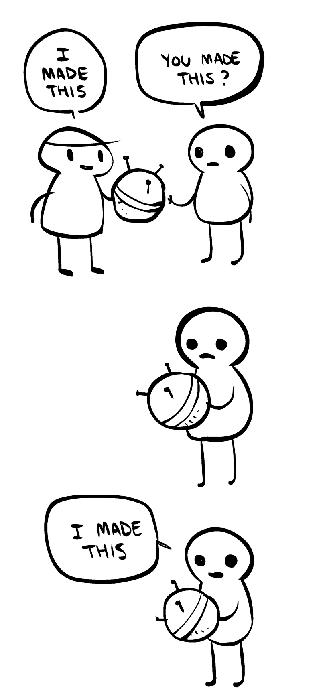
(You can follow Anthony on Twitter as @nedroid.) And here's a longer comic by John Cullen, originally posted here on his website. Follow him on Twitter as @nellucnhoj.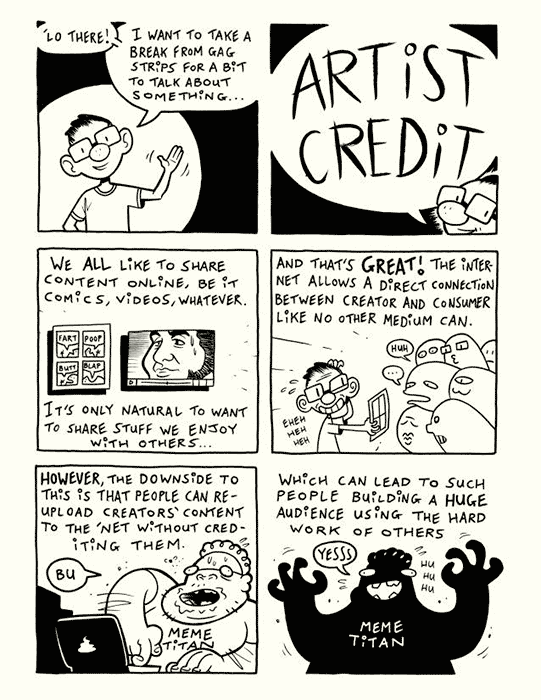
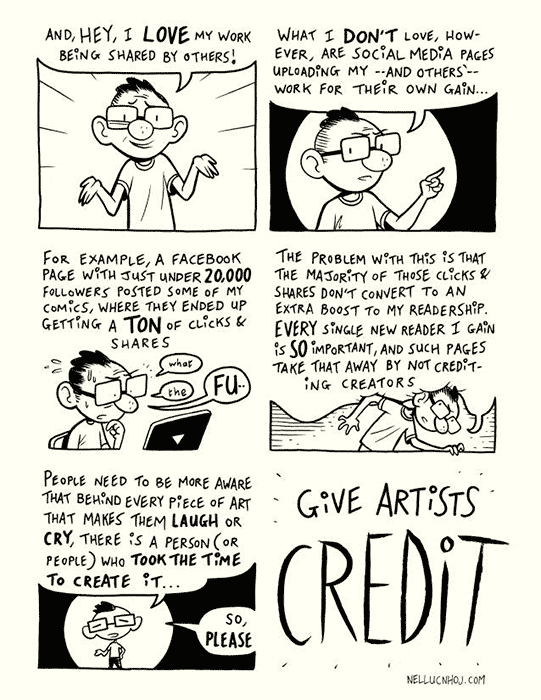
There's a similar hashtag to #PicturesMeanBusiness on Twitter, the #ArtCred tag, originally created by comics artist Declan Shalvey. You can read some of his blog posts about it here.
This is all good stuff! Basically, #ArtCred and #PicturesMeanBusiness are trying to do the same thing: get artists fairly credited for their work so we can keep doing the jobs we're best at. I think the way that #PicturesMeanBusiness differs a bit from similar campaigns is its emphasis on business interests. When I first started making a fuss, illustrators and comics people told me that illustrators had complained before, and occasionally there would be a blip of sympathy for the cause, but then people would move on and forget about it. Which is why I thought it might be wise to take a slightly different tack: not only is it right and fair to credit artists (doh!), but it's actually in the interests of business. Book industry, we're not just trying to win your sympathy, we actually make you money! And we can make you MORE money if you give us a chance to build our careers.
Whether we like it or not, publishing is a business, and people listen to money. Here are some reasons to consider why crediting illustrators may be financially worthwhile:
* To publishers and media: Readers love the idea of a collaborative partnership. Many people wish they could draw. They don't like to think of the illustrator as a forgotten hack. For the media, showing two different people working together (or even occasionally arguing!) creates an interesting real-life story in readers' heads. People will look out for books by that beloved team of creators. Even with celebrities, people love the idea of a celeb working with an artist in a different field; a publicist doesn't have to fake it that that singer/actor/whatever can draw. Publicists, big them up together in your press releases, even if you put the writer's name first.
* To writers: Be good to your illustrators and they might be good to you. Once you start a series, the artwork very much becomes the brand of that series. If a writer doesn't make an effort to make that job worthwhile for the illustrator, sharing the spotlight, the illustrator may find better work and leave the series in a lurch. If the editors and art directors are unsure about continuing the series, an illustrator dropping out may make the decision for them. If illustrators are paid enough and sense book series are helping their careers, they will be much more likely to stick with them. Don't be that negligent writer with the illustrator who's dying to leave you.
* To booksellers: Pictures sell books. Sometimes readers latch on to the name of a beloved picture book writer, but often they'll see a book across the room and recognise the look of it, and pick it up because it's the illustrations they love. (Perhaps they loved The Gruffalo and they see work by its illustrator, Axel Scheffler, paired up with another writer's work.) The pictures may sell the book! So it makes sense to stock books by popular illustrators as well as popular writers. But it's nearly impossible to track illustrator sales figures across their books; people don't usually request this information from Nielsen, the major data provider. If Nielsen gets more requests for this information, they may start making it more readily available. (Read more about metadata issues here.) Do you want this information? Let Nielsen know. If you run an online bookstore, be competitive by making books searchable by illustrator as well as by writer. People may want to look up a book by illustrator and if they can't find it on your website, they'll click over to one that will give them this information.
(Find out more about the campaign at PicturesMeanBusiness.com.)
___________
Other news:
I've been busily working away on a new picture book! I'm not allowed to post images yet, and it hasn't left me a lot of extra doodle time. But I grab it when I can! Here's a drawing posted yesterday by writer-illustrator Chris Priestley, 'Melancholy warrior'. I riffed on it with my 'Grumpy warrior':
Also, #PicturesMeanBusiness has been out and about: I went with my studio mate Elissa Elwick to a party hosted by The Bookseller, to launch their new FutureBook conference series. I'm going to be taking part in a panel and talking about #PicturesMeanBusiness at their Author Day in London on Mon, 30 Nov. (You can read some early details about it here.) I think we might find some good allies!
Reception parties don't always make for great photos. But I thought this one was particularly splendid: 
Elissa and I scampered off to VooDoo Ray's for pizza afterward, much recommended for late-night grub. 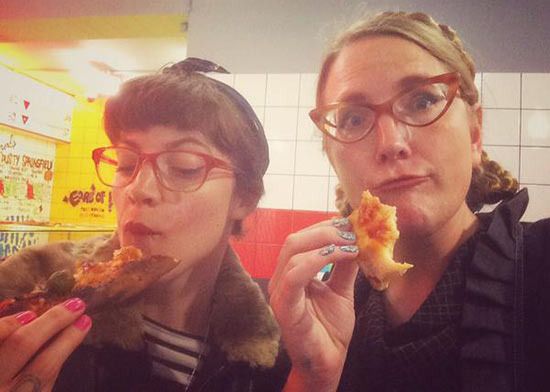
Oh, and Talented Colleague klaxon! Patrick Ness" has already spotted a copy of Philip Reeve's new book, RAILHEAD! (Philip hasn't even seen the final book yet!) I've read this and I'm super-excited about it. 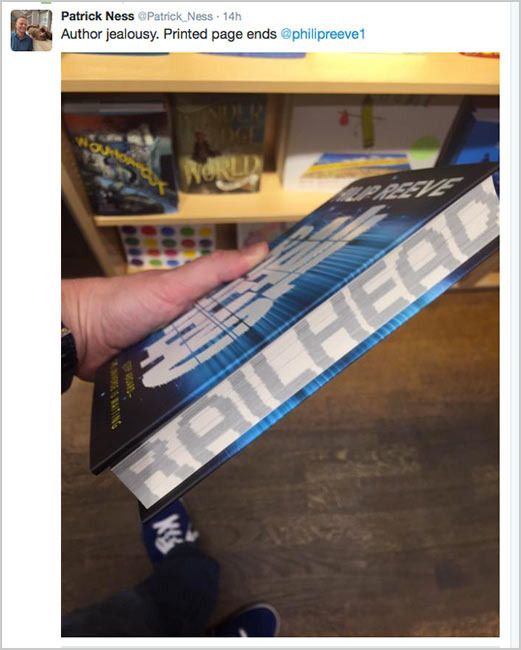
Patrick has led an amazing campaign of people donating to Save the Children, a charity helping with the current refugee crisis. Lots of well-known writers have chipped in huge sums to match public giving. Here's a current screengrab and you can visit the donation page here!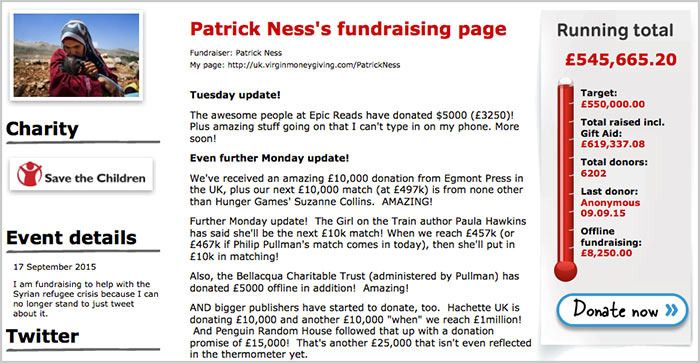
Lots of love from Elissa Elwick, Gary Northfield and me at the Fleece Station studio, signing off... xx
Blog: Sarah McIntyre (Login to Add to MyJacketFlap)
JacketFlap tags: pictures_mean_business, Add a tag
Big thanks to everyone who's supporting the #PicturesMeanBusiness campaign! We're making a bit of noise: right between Heathrow security and boarding my flight to the USA, I got e-mails from both Kat Brown at The Telegraph and Alison Flood from The Guardian, wanting to report on the campaign. I managed to borrow a laptop in the USA to do a Skype interview at my friend's dinner table with Dan Damon for the BBC World Service. I haven't had a chance to link to them properly, but here they are now, and I've posted them onto the 'Further Reading' section of PicturesMeanBusiness.com.
Kat Brown in The Telegraph, read it here: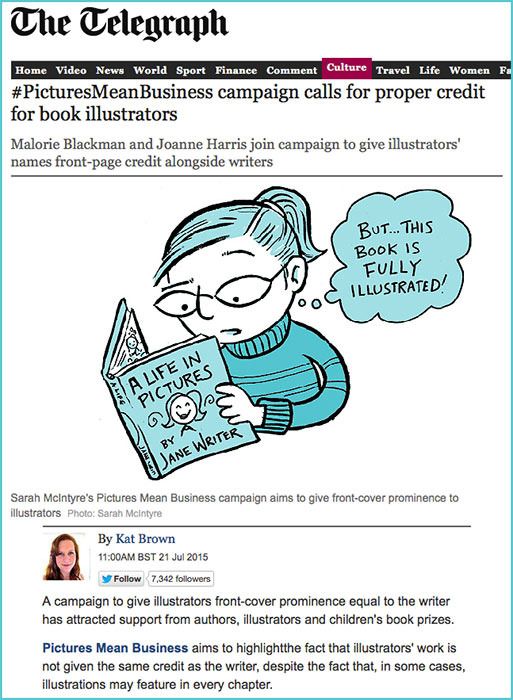
Alison Flood in The Guardian, read it here:
Dan Damon interviewing me on BBC World Service, listen here: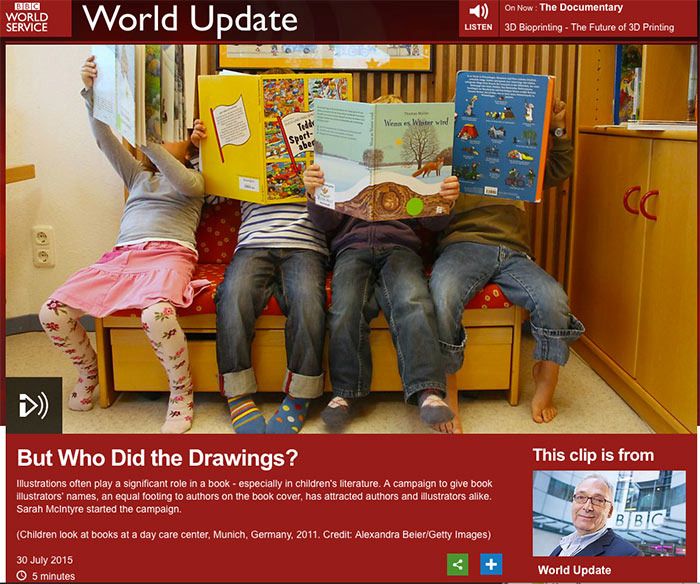
We still have a long way to go. I was sorry to see Mariah Carey's new picture book won't have the illustrator's name on the cover (implying that Mariah has taken to painting). 
I was hoping to big up the book's illustrator, Colleen Madden, on Twitter but she doesn't have an account. I understand the need to use a big celebrity name to sell a book, but it's dishonest and misleading not to mention the illustrator on the front cover, at least in smaller letters. Publishers may argue that they credit the illustrator on the back cover or inside the book, but these aren't what people see when they browse book covers on the Internet. Particularly with a PICTURE book, big credits for the illustrator should be a no-brainer decision for the publisher.
Jarry Lee on BuzzFeed, read it here

Blog: Sarah McIntyre (Login to Add to MyJacketFlap)
JacketFlap tags: pictures_mean_business, Add a tag
It's great having the support of writers for the #PicturesMeanBusiness campaign: our previous Children's Laureate Malorie Blackman was one of the first writers to support it, Philip Ardagh asks questions when illustrator names are left out of articles featuring illustration, Joanne Harris tweeted a list about illustrators, and of course my co-author Philip Reeve has been right there with it all along. I think it adds extra weight to the arguments when writers fight for us, like we're in it together. When I first started talking about it, writers on Facebook were quick to point out how much they value their illustrators and cover artists.
But even writers who talk about the importance of crediting their team still forget to credit them at key publicity moments. Why do they do this? I think many non-illustrators in the world of publishing are completely clueless about everything related to illustration. They think it's something quickly added on at the end of the book process to make it extra-shiny. But they don't understand what illustration actually involves. 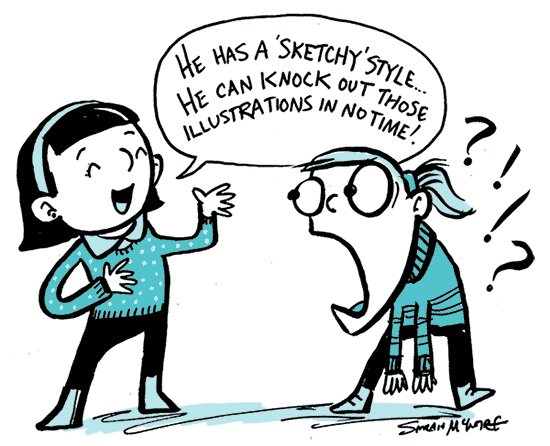
Here are a couple of real-life scenarios (genders may have been changed for anonymity):
Scene one: A writer raved about his new book cover on Twitter, even writing a detailed blog post about how much he loves the artwork and why he loves it. But he forgot to mention the name of the illustrator, much less link to her. Why? There was no lack of space to write that information, he just didn't think of it.
But isn't it obvious, to link illustrations with the person who made them? Perhaps the writer saw it like I do when someone compliments me for my outfit and I just say 'thank you', instead of telling the person who designed each item (because they didn't ask). But I still find it VERY strange when someone compliments a writer on their book cover art and they just say 'thank you' instead of saying 'Isn't it great? It's by Joe Illustrator!' In this case, the person just needed a gentle private reminder and he fixed the blog within minutes. (Funnily enough, I find myself talking a lot about my tailor to people these days when they compliment my dresses.)
Scene two: A publisher got in touch and told me a writer has been asking to have me illustrate her children's book (fiction, with chapters). I had tight commitments to do other work, but I knew the writer a little bit and thought, well, maybe I could do the work in the gap times. I read the manuscript - it was pretty good - and I could see ways I could inject a lot of extra humour into it through the pictures. I wrote back to the editor to find out what sort of deadline I'd have, and she replied, 'One month'. WHAT? Okay, so there's no way I could do that in the gaps. The designer wanted over 150 illustrations so it would've had to have been my full-time job. I wrote back saying I couldn't do it in that amount of time. We wrote back and forth a couple more times and the correspondence took about a week.
I ran into the writer at an event a couple weeks later. We had a chat about the book and I apologised for not being able to illustrate it.
'I can't believe they would only give me a month to do all the pictures', I said, with a rueful expression on my face. To my surprise - and horror - the writer smiled broadly and said,
'But isn't that great?!'
'What...?'
'It means the publishers really want to push my book, to get it out there!' she gushed. 'They're not going to let it sit around.' I gaped at her. This was a writer I knew had spend at least a year, possibly YEARS, preparing this manuscript, taking it to critique groups, crafting it to be just right.
'But it's not fair on the illustrator', I protested. 'Over 150 illustrations in... well, now it's three weeks, not a month'.
'But that's okay,' said the writer. 'He has a really sketchy style and he can just knock them out in no time.'
By this point I was almost on the floor, overwhelmed with grief for this poor illustrator. The writer had NO IDEA how much time and effort that illustrator might be taking to work out the layout with the designer, come up with the looks of the characters, get the drawing compositions right, etc. The illustrator might have to make five painstaking under-drawings of a picture before tracing over it in that 'sketchy' style that looks so effortless.
The book came out, the writer was thrilled with the pictures, which weren't amazing, but still surprisingly good, considering how fast they'd been done. But my heart hurt for the illustrator, I hope he hadn't had any family crises or anything during that time. He must've needed the work very badly to have agreed to that time schedule. The writer proceeded to publicise the book vigourously, never mentioning the illustrator's name unless directly asked.
I made a vow to myself that I would rather change professions before agreeing to work with that writer. And I don't think she ever had any sense that what she'd been saying to me was so horribly offensive. I later heard her saying she might self-publish and illustrate the next book herself because 'Diary of a Wimpy Kid is practically stick figures and that sells well'. ...There are stick figures and there are stick figures. I didn't even know how to respond, in any way that she could understand. If she can pull it off, more power to her, but I have my doubts.
Writers often like to cast themselves in a very romantic light. They tweet about their process, staring thoughtfully out windows, drinking too much coffee, trying to pull something from the depths of their souls. But I think this is sometimes how they understand writing and illustrating: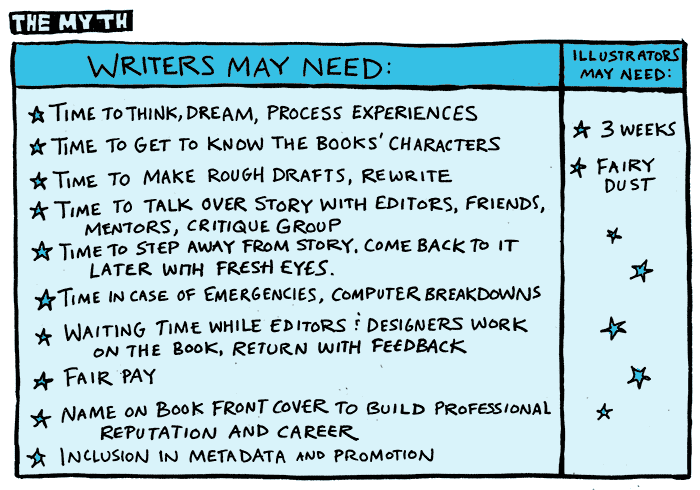
And they are very wrong. Here's the truth. (And I think much of this also applies to translators.)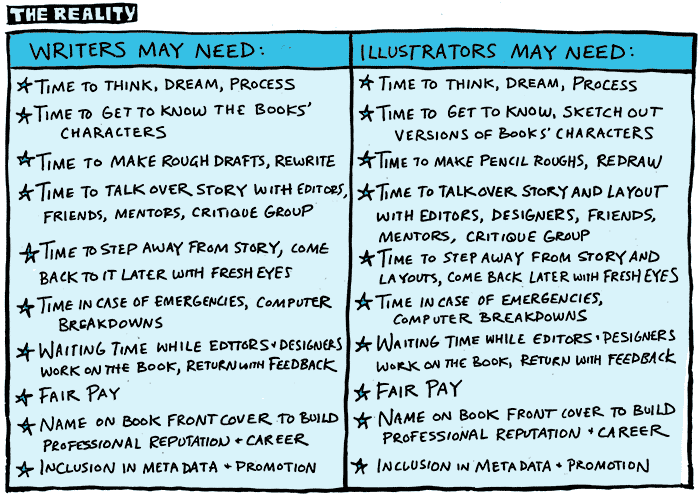
But it's not just writers who underestimate what goes into illustration (and translation); publicists are forgetting even to include information that their books are illustrated. Publishers, why bother spending money on illustrations if you're not even going to mention them? Isn't that false advertising? You're either pretending the book isn't illustrated, or you're pretending that the writer made the illustrations. And don't say 'but the illustrator's mentioned on the back cover'. No one looks at the back cover when they're browsing online.
Fortunately we have a #PicturesMeanBusiness ally in Fiona Noble at The Bookseller. Here's her article from this week's magazine. Publicists, people WANT illustrated books. Don't be ashamed of the illustrations, don't forget about them, and certainly don't forget that it was a real person who created them. Writers, remember that illustrating may be a long, thoughtful process, too, and it's worthy of credit. 
(Find out more at picturesmeanbusiness.com and browse the #PicturesMeanBusiness hash tag on Twitter.)
Blog: Sarah McIntyre (Login to Add to MyJacketFlap)
JacketFlap tags: pictures_mean_business, Add a tag
People have been asking me, ‘How’s it going with the #PicturesMeanBusiness campaign?’
I’ve heard some good feedback that it’s starting to make a difference, that people in publishing are more aware of the impact they can make on illustrators’ careers by crediting them for their work. But important lists of illustrated books keep popping up with illustrators’ names omitted, from book-loving people you’d think would know better, and they usually assign the blame to incomplete or faulty digital data.
So how’s it going with the whole metadata issue? Are we any closer to sorting out the problems? 
On Wednesday, I met up with Jo McCrum and Nicola Solomon from Society of Authors, Loretta Schauer from Society of Children’s Book Writers & Illustrators, journalist Charlotte Eyre from The Bookseller magazine and Andre Breedt from Nielsen, the company which compiles and provides the majority of book data. Andre Breedt was incredibly helpful and supportive of the campaign, and explained to us some of the bare bones of how the book data system works, and spent time thinking with us about ways we could try to improve the situation for illustrators (and translators). Here are some of the things I learned, and some conclusions we drew from the meeting, about what we all need to do to make things work better:
* Illustrators and illustrator agents: you need to be more attentive with CONTRACTS. The best way for a illustrator to get his or her name on the front cover of a book is to get that promise in writing. Illustrators, you or your agents need to HAVE THIS DISCUSSION with your publisher. (This is particularly important if you're illustrating educational material, so-called 'middle-grade fiction' or 'illustrated chapter books'.)
Don’t wait until you’ve finished illustrating half the book to finalise this stuff. Don’t work on the promise of a contract. Get it before you begin working or it may be too late; you may get a nasty surprise when the book comes out uncredited to you.
A phrase recommended in your contract by the Society of Authors lawyer at the meeting was ‘front cover credit with due prominence’. You can haggle with how big the lettering needs to be, but at least your name will be on the front cover. If you’ve done a lot of illustrations and the publisher refuses to put you on the front cover, this is a big deal, a blow to your branding, and may mean you have a harder time getting festival appearances and paid author visits. In that case, you need to decide (with your agent, if you have one):
1. If the publisher insists on not crediting you at all, will the publisher pay you a significant extra amount of money to compensate for this?
2. If you can come to another arrangement (say, your name on the title page, back cover, etc), are you happy with the pay and do you think the credit accurately reflects the amount of work you’ve contributed to the overall book?
3. After negotiating this, is the job still worth it, or should you turn it down?
The most important thing is that you’re clear about this important negotiation point from the beginning and the decision isn’t some sales team afterthought.
* Book charities and organisations, people who run award schemes, booksellers, journalists: assess your own practice. You may be in a rush, but don’t blindly accept what you’re given when you cut and paste data. If you’re making the effort to single out the books for recognition, take the time to make sure you’re correctly crediting the people who made them.
You may need to look at an actual copy of the book. 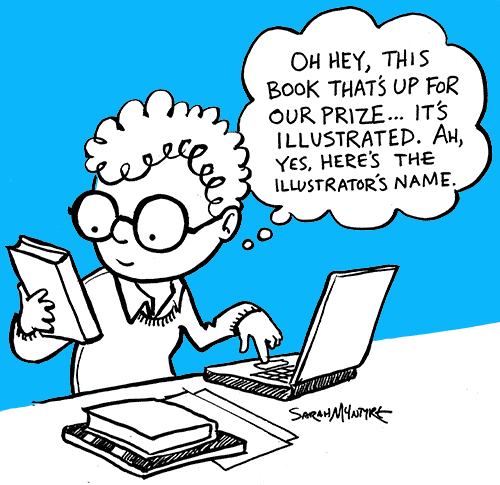
* Publishers: assess how your data works. To get illustrator data right, we need you to do three things:
1. Be sure you're using standardised data (more about this in a moment).
2. Be sure you (or your intern) fill out the box that asks for the illustrator's name (or 'populate the field' in data-speak).
3. When you request data, be sure to ask for the field that includes the illustrator data. If you don't ask for it, Nielsen won't force it on you.
Let me unpack those a bit.
1. Be sure you're using standardised data. The reason we keep having problems is that no one has a brand-new system. Almost everyone has what data people call 'legacy systems', which were designed for a certain purpose, years ago. As the book trade evolved, people made little additions and repairs along the way, instead of getting brand-new system.
For example, a lot of systems were designed for warehouse use, to help people shift around big boxes of books. For the purpose of moving boxes, all they needed to know was if the right books were in the right boxes, how much they'd weigh, and how they'd fit onto a lorry. So there was no reason they would pay to add extra information about an illustrator to the system; it genuinely didn't matter for those purposes. 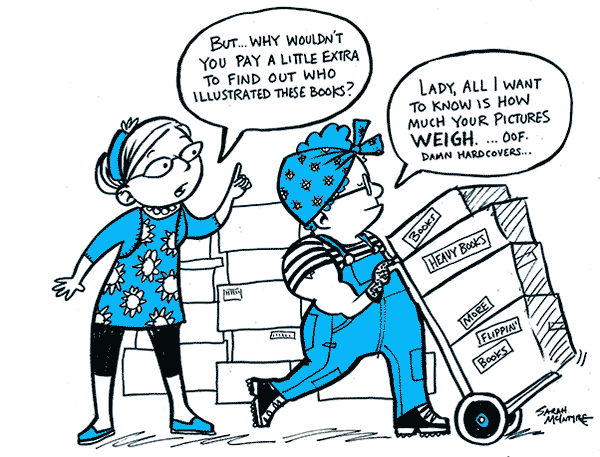
As time went on, these warehouse systems evolved into what customers used to order books, online shop front (or in data-speak, 'front-end facing') systems. So the same system that dealt with box weight was gradually being asked to deal with customer reviews, star ratings, interesting details about the authors, other book recommendations, etc. And some systems made the transition better than others; transitions costs money. Some companies would get the illustrator data from Nielsen, but their own software wasn't detailed enough for all the data to make the transition to their website, and they could only make manual changes if they wanted to include illustrators for their customers. (Hive Books have been good about adding illustrators when asked, but they're working on improving their overall system.) 
For awhile I thought Nielsen didn't actually have a data field for the illustrator. Like most illustrators, I don't have access to their system since I'm not a subscriber, so I couldn't check. But Nielsen DO have this field. Here's the information the Nielsen rep pulled up for my picture book, Dinosaur Police. (And we were both pleased to see Scholastic UK had been filling out all the right data.)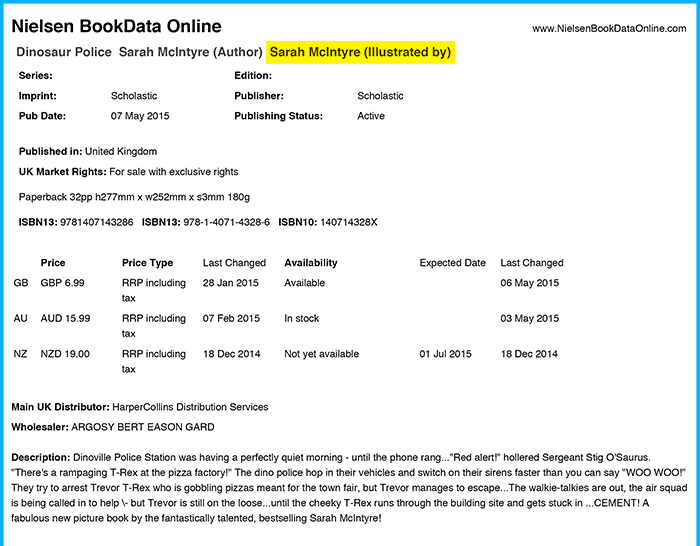
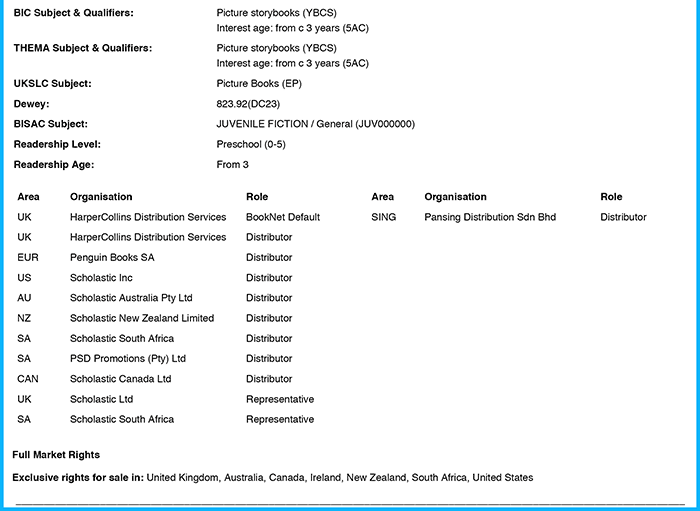
At the meeting with the Nielsen rep, I learned a lot of behind-the-scenes things. If you're trying to understand how it all works, it's important that you understand the roles of these groups: 
Nielsen BookData is a business. Nielsen provide a lot of services that help the book trade run effectively behind the scenes. They provide ISBNs for all books published in the UK and Ireland. They collect information on books from publishers, and sent it out to booksellers and libraries, arranged how they want it. They provide electronic ordering services to enable booksellers to order the books for their shops, and they provide the sales and market information, including the bestseller charts. Nielsen data can easily be accessed in standard formats, but if you want a bespoke service, it will take a little longer and cost a little more. 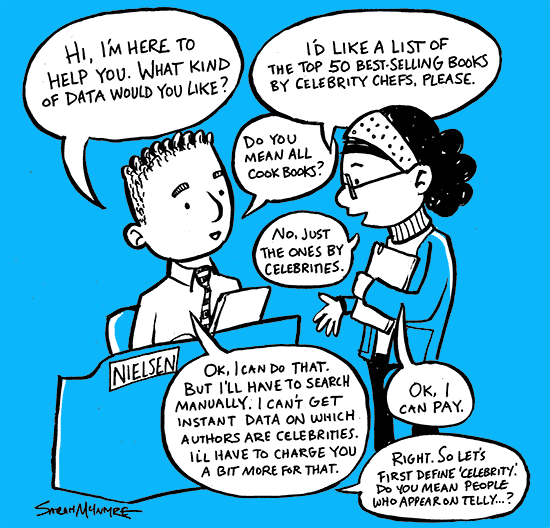
They have two main systems: a bibliographic system and a sales system. So if you're a librarian and want to know all the details about a book, you'll use their bibliographic system. If you're an editor at The Bookseller and want to know whose books are selling best, you'll use the sales system. You can find out which writers' books are selling best, but unfortunately you can only get illustrator information from the bibliographic system. So if you want to know bestselling illustrators, they can get that information, but they have to do it manually. People don't request that information often enough for it to be worth the money they'd need to spend putting illustrator data into the sales system.
Another organisation worth knowing about is BIC, the Book Industry Communications Group. 
BIC is an independent body set up to promote standards in the UK book trade. For instance, the ISBN is a standard, and it’s hard to imagine how the book trade could possibly work without it now. Standards help all the players in the industry, and all the different systems, communicate with each other more clearly. BIC’s website statement reads:
BIC is an independent organisation set up and sponsored by the Publishers Association, Booksellers Association, the Chartered Institute of Library and Information Professionals and the British Library to promote supply chain efficiency in all sectors of the book world through e-commerce and the application of standard processes and procedures.
But BIC just deal with UK standardising. (Its director is Karina Luke.) There’s another group that deals with standardising in other countries, particularly European countries, called EDItEUR. (Its director is Graham Bell.) 
All these countries doing things differently sounds very complicated, doesn't it? They think so, too. So EDItEUR are trying to set up a huge overarching global classification system for books, called Thema. (The chair of this is Howard Willows, from Nielsen.)
But how do publishers get their data to Nielsen(so they can put it all together in one place and make it useful)? Lots of different ways, apparently. In the old days, they used to send Nielsen actual books, but they get hundreds of thousands every year, so they had to stop doing that. The way they most prefer publishers to submit data is by using a system called ONIX. 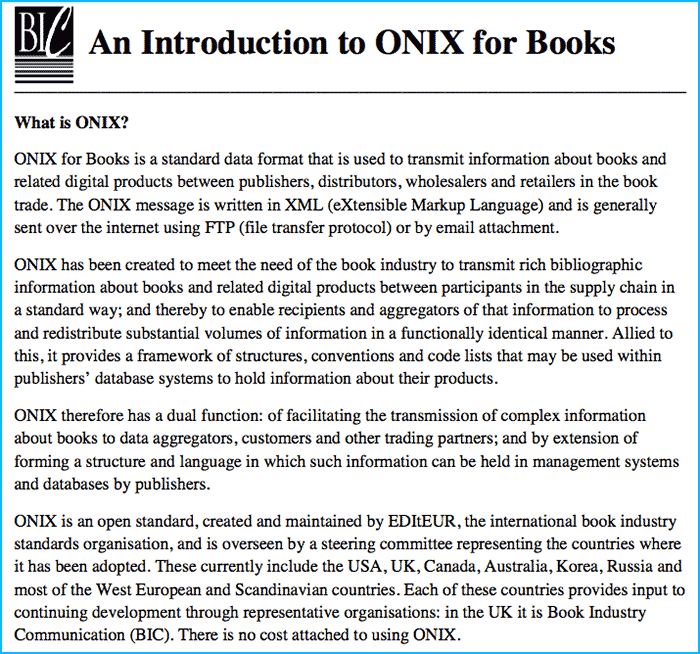
ONIX is the system BIC and Nielsen says really works, and ONIX is regularly updated to meet modern publishing needs. You can see it in the recent additions they've made for entering comics data, including colourists, inkers, letterers, etc:
In Nielsen's ideal world, everyone would use ONIX. But the problem is that not all outdated publisher systems can handle ONIX. So BIC have also created a bare-bones system called BIC Basic, and well, if major publishers can't handle the basic data they need for to submit for that, they're really failing us.
But faulty systems aren't all that's happening. Which brings us to the second point about how we need you to fill in all the data fields. Some publishers (or their badly trained interns) aren't filling in even the most basic things, including illustrator name. Fiona Noble at The Bookseller has been noticing this: 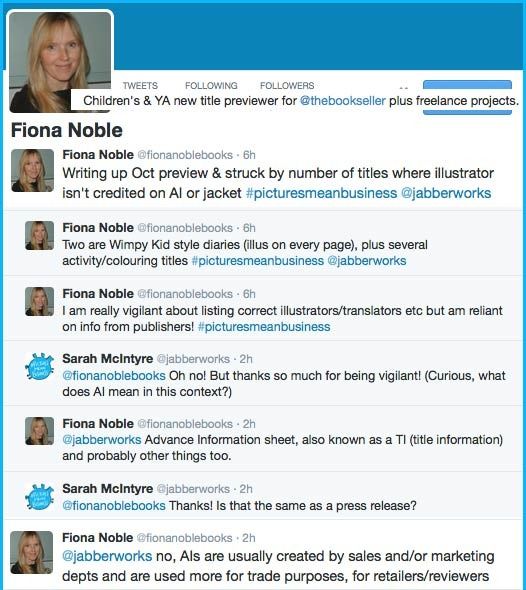
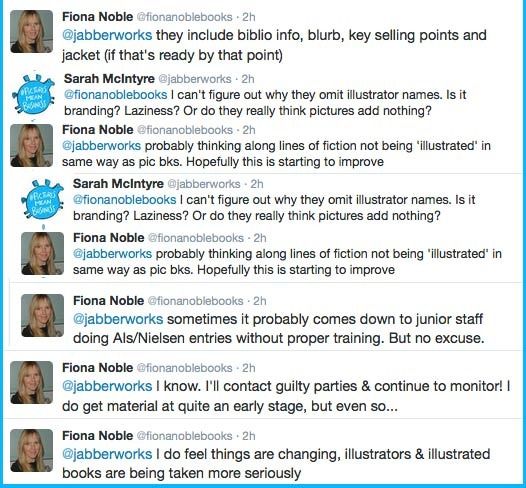
Publishers! To support #PicturesMeanBusiness, you **need** to have a meeting with your marketing and publicity people - particularly the young, clueless newbies - and let them know that press releases and Advance Information sheets without illustrator information are Not Good Enough. Fiona will back me up on this, and she's one of the people you're trying to impress. For us to pull out good data, you need to put IN good data. 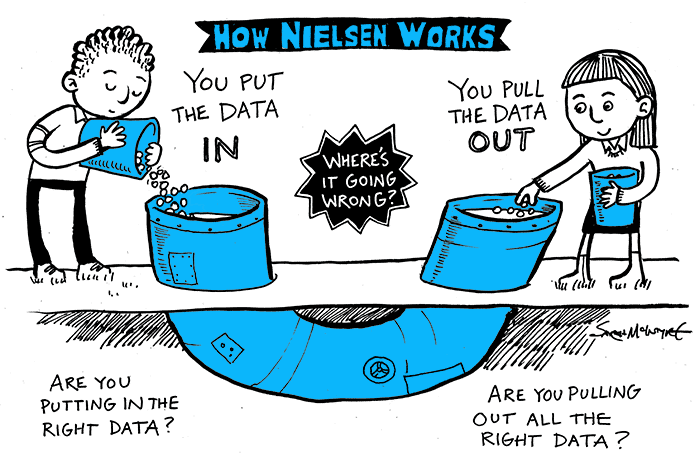
No, I am not saying Nielsen is a series of tubes.
And that brings us to the third point, about requesting illustrator data. If your 'legacy system' is still stuck in warehouse mode, illustration won't be one of the fields you will have requested when you ask for data from Nielsen. The way the system works is you put in data, then you pull out the data you want. If no one wants to pull out illustrator sales data, then Nielsen has no financial incentive to link up their bibliographic illustrator data with their sales illustrator data. They'll make a one-off chart for you for a small fee, but that information won't be easily accessible on a regular basis.
Another reason Nielsen isn't very focused on illustration is because illustrated children’s books are only a tiny part of the books Nielsen deals with. The majority are works of academic non-fiction, and these often have many, and all sorts of, contributors.
Why do so few people want this illustrator sales information? If our economic value can't be assessed, we'll be forgotten by business people and written off as not contributing anything to the economy. Not even The Bookseller credited illustrators in sales charts until March of this year. You could see that Julia Donaldson was ruling the picture book sales charts, but you had no idea how The Gruffalo's illustrator Axel Scheffler's books were doing. In fact, if you entered his names into the Nielsen sales charts, he came out as quite a low moneymaker, since only the books he's written himself were calculated.
This omission plays out in real business decisions: certain airport bookshops ONLY stock books by Julia Donaldson because she's a sure-fire hit with buyers. But who's to say that these sure-fire hits aren't her books with Axel Scheffler? If Axel illustrated books with other writers, might these books sell just as well? They would have that recognisable look of Axel's that makes customers pick them up. The Bookseller have made huge strides recently in supporting illustrators and including them in their magazine. In the 15 May issue, jouralist Charlotte Eyre even commissioned a manually-compiled illustrator sales chart from Nielsen:
But this isn't the case in most media. Children's book coverage is getting smaller and smaller amounts of space in printed newspapers, and if someone wants a sales chart, they have a very limited budget and almost no space to put it in, so they're not going to go out of their way to add space for illustrator names. 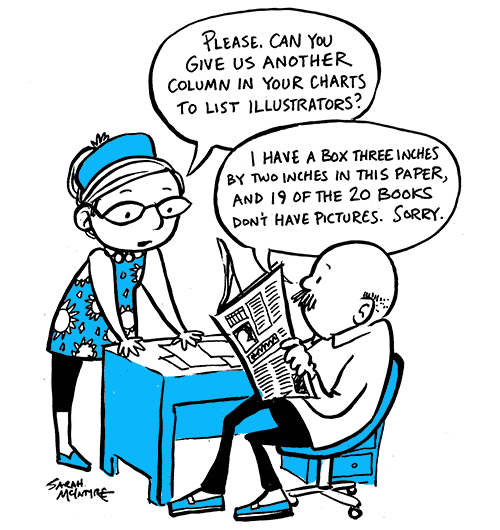
When the illustrators get left out of their data, the newspapers forget illustrators have anything to do with books at all. You'll start to notice it now, mentions and reviews of picture books and highly illustrated fiction that only mention the writer's names. It trickles into the wider culture and schools only invite writers to give talks to their children, not realising how inspiring illustrators can be to getting their children reading, writing and drawing, all at the same time. (And many illustrators only survive in business with the supplement of school visit payments.)
So how do we prove our economic value? I don't know. We're not the sort of people who generally go on strike, and we don't have a union. (The Society of Authors is the closest thing we have to a union.) The thought of shelves and shelves of books without illustrations or cover art probably frightens illustrators more than it does publishers:
If we went on strike, books probably wouldn't all go blank. Publishers could probably stumble on for a couple years using in-house designers to do everything, using pre-bought typefaces, clip art and stock images. It would be ugly and start a counter-wave of self-published indie stuff, but their efforts would go on longer than illustrators could afford to sit out unemployed.
We need the help of people who know about metadata. Is that you? #PicturesMeanBusiness isn't an organised team, just a bunch of concerned people; if you're on Twitter, that's the easiest way to jump in, using the #PicturesMeanBusiness hashtag. From what I gather, Nosy Crow publishers are very up to date with digital technology, Usborne are good at crediting everyone, Glen Mehn of The Kitschies Awards has data experience, Georgina Atwell of Toppsta gave a talk on metadata at The Bookseller conference, Sara O'Conner has programming experience.
We may have a hard time solving this data problem. But we can make huge inroads into the cultural problem of illustrators not being credited, and the faster, the better. We need you book people, helping to promote illustration, where you can, right now. And it’s not only because you’re warm-hearted book lovers, it’s because you know that in this culture which relies on images more than ever, it’s our pictures that are selling your books, and you don’t want to miss any tricks: you want to sell more books. It’s business. Support our careers and help us stay in work making your books sell.
www.picturesmeanbusiness.com
Blog: Sarah McIntyre (Login to Add to MyJacketFlap)
JacketFlap tags: riddell, pictures_mean_business, Add a tag
The new appointment of Chris Riddell to the post of Children's Laureate means so many good things for illustrators and everyone who loves illustration! Not only is he hoping to get lots more people drawing - parents, as well as kids - but he's a big supporter of our #PicturesMeanBusiness campaign. Hurrah! 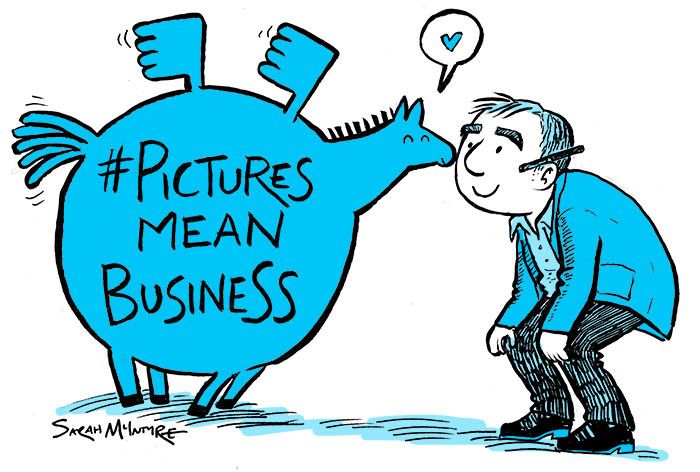
Here's an article by Charlotte Eyre in this week's edition of The Bookseller:
(You can read the rest of the article here. Thanks so much, Chris!!)
Here's a photo of me at the award ceremony with Chris's co-author Paul Stewart, who's worked with him on The Edge Chronicles. They're an awesome team and live just a few houses away from each other! 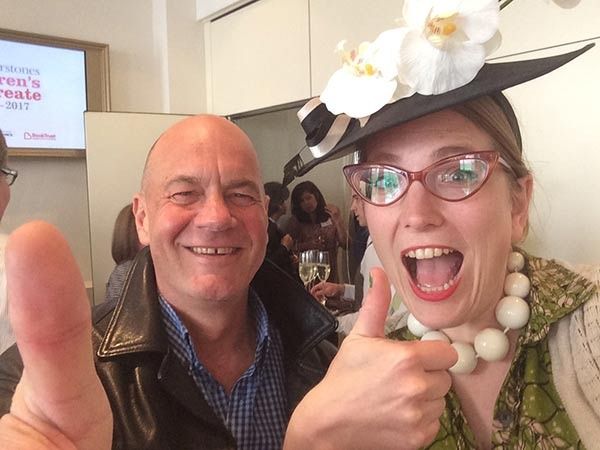
I didn't get to talk much with Chris at the Laureate ceremony because he, predictably, was mobbed by fans and press the whole time. You can spot former Laureate Malorie Blackman, who's a big supporter of #PicturesMeanBusiness.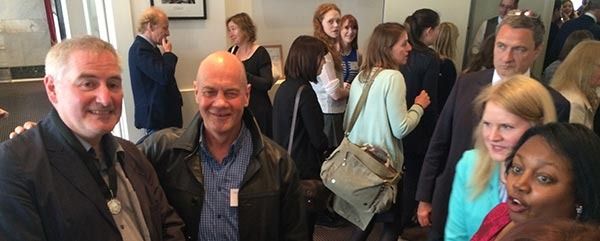
It was a big change from 2010 when The Graveyard Book won the Carnegie medal and Neil Gaiman was getting mobbed in that exact same room, and hardly anyone was paying attention to Chris, so he was free to have a long chat with me. (Some photos here from 2010.)
Chris Riddell at the Carnegie-Greenaway ceremony in 2010 with David Roberts and Viviane Schwarz
Those were different times, when the illustrator wasn't even credited in the award listing, despite having a huge role in creating the book, and Chris Riddell was slightly forgotten. 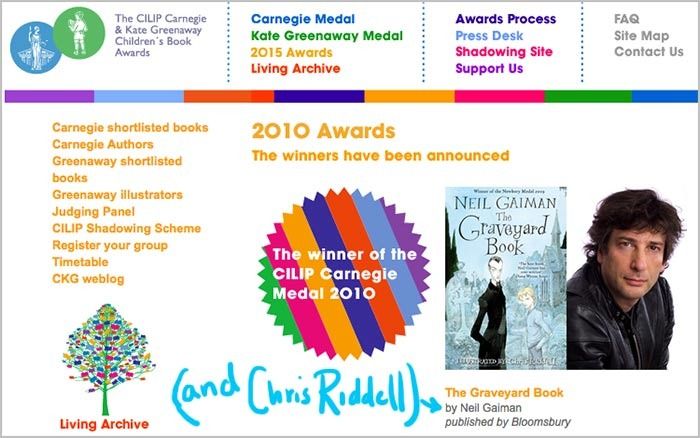
Thank goodness Joy Court and the Carnegie Greenaway committee were quick to see the error of this, and now illustrators are listed when an illustrated book is up for the Carnegie award. (Writers had always been listed with the books up for the Greenaway illustration award.)
But... dodgy book meta data is still creating huge problems. Here's a listing of the top book sales at Hay Festival, with the illustrators left out. (Chris even won a big illustration prize at the festival.) When I commented on the listing, the person who'd written the post edited it, but it was only later that the Dutch translator of The Parent Agency, Sandra Hessels, noted that Baddiel's book was actually highly illustrated by Jim Field. But I think the post was deemed too late to edit by then. 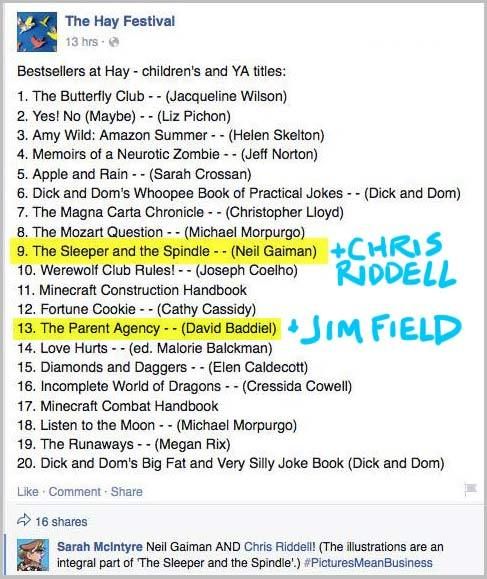
To be fair to the Hay bookshop person, I wouldn't have realised Jim had highly illustrated The Parent Agency either, and I'm a huge fan of Jim's work. He's not listed in the book data provided to Amazon, which suggests his publisher didn't fill out all the necessary boxes in the forms they submitted.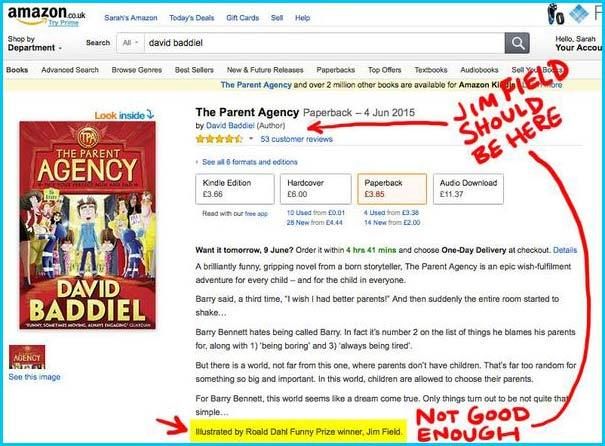
I wouldn't have realised the book was illustrated at all, and that's because his name's not written on the front cover. Eek, look, it's there in tiny letters under the bar code, on the back cover... there, under the pigeons. 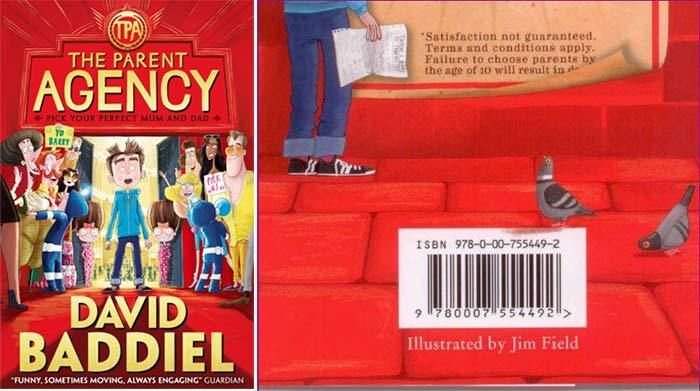
With the way the covers are designed, big lights on the front, street pigeons on the back, it reminds me of that Pet Shop Boys song that goes: We're... the bums... you step over as you leave the theatre...
That's not right. Jim says he spent at least two weeks working on that cover alone, and he should be listed at least somewhere on the front cover. I know the HarperCollins marketing people see writer and comedian David Baddiel as the big attraction, but it's actually misleading; you wouldn't be able to know this book was illustrated if you just saw the cover. And the front cover is what most people see if they buy the book online, or pick it up in a shop. David was quick to point out on Twitter that he always credits Jim, but the Sales & Marketing people should have been more honest with the wording they put on the cover. As Jim's pointed out, this lack of cover credits is a HUGE problem in illustrated fiction, and just because an illustrator doesn't raise a big stink, it doesn't mean they're not completely gutted by the decision to omit their name. The Dutch publisher was clued in enough to include Jim. His name's not as large as David's, but at least it's there.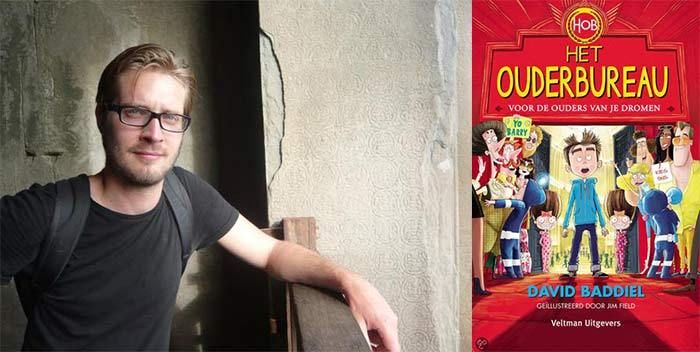
Photo of Jim Field from the United Agents website
Editors, designers, marketing people, this is a BIG ISSUE: please don't take the decision lightly to omit your illustrator's name from the front cover. Here's what you're doing:
* Refusing the illustrator the chance to build up their own name branding
* Denying potential buyers the information that the book is illustrated
* Telling the public that illustration is far, far less important than writing and denying readers a hero alongside the writer
* Making it hard for illustrators to take part credibly in Author Visits (denying them a further source of income and publicity)
* In the case of a television celebrity writer, you're saying that television people are much more important than book people. Is this something you really want to say, if you're going to try to sell more books? Aren't you shooting yourself in the foot by doing this?
Illustrators don't get salaries or pension plans like in-house publishing people. They need all the help they can get to build their brand and keep their career going. If you decide you can't possibly credit them (a lame decision), you should pay much, much, MUCH more money. Why not just credit them? Get with it, people.
So what's happening? I'm going to a meeting next week between The Bookseller, Nielsen, the Society of Authors and the Society of Children's Book Writers & Illustrators to discuss this problem. I originally thought Nielsen was the culprit, but it's looking more and more as though Nielsen are just dealing with the data they're given, and publishers are submitting faulty, irregular and incomplete data. Keep an eye on The Bookseller and Charlotte Eyre's articles for updates. But we need you to keep up the pressure on publishers to submit complete metadata, ask questions when illustrated cover art is revealed with no illustrator mention, reviewers leave out illustrators, and illustrators are left off front covers of highly illustrated books.
And I hope Chris will keep pushing for awareness about crediting illustrators; we're all in this together and as an illustrator, he knows exactly what it's like to be left out of listings where he should rightfully have his name. Visit picturesmeanbusiness.com if you want to catch up on what the campaign's about, and browse the #PicturesMeanBusiness hash tag on Twitter. 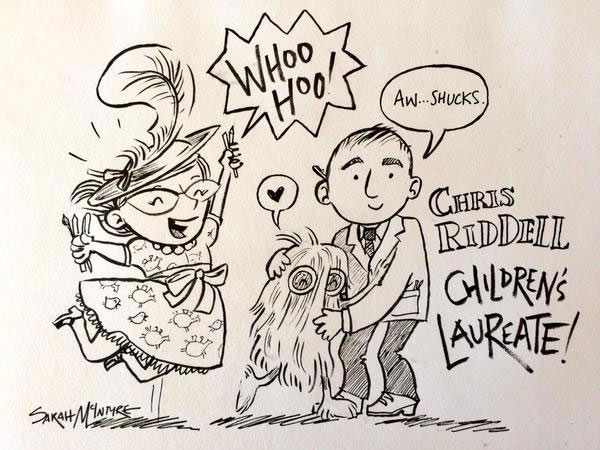
Here's another photo from the Children's Laureate ceremony: fab writer-illustrator Liz Pichon with her predictive fingernail. 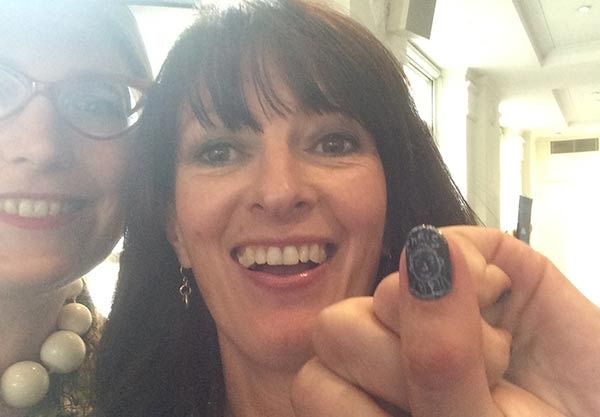
Our Oliver and the Seawigs and Cakes in Space OUP publicist Harriet Bayly took my co-author Philip Reeve and me out for lunch after the ceremony. Funnily enough, that 2010 Carnegie Greeaway ceremony was the first time I ever met Philip, although we only exchanged a few words when I snapped his photo. 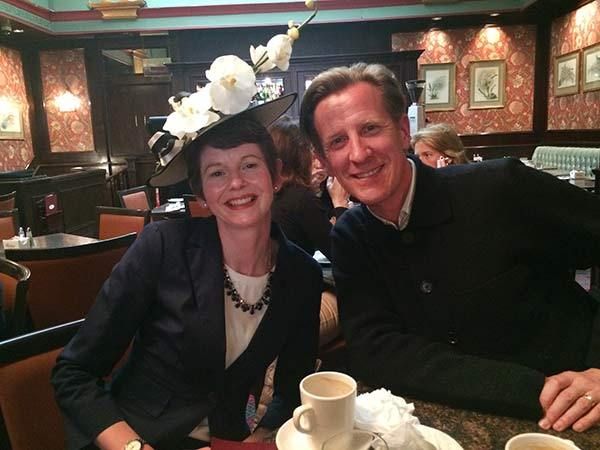
Philip was the person who originally came up with the Pegasus for the #PicturesMeanBusiness logo. It started out as a piece of wood he painted: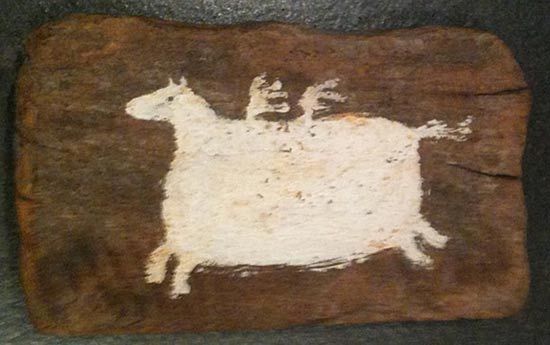
And together we turned it into an illustrated online story called The Dartmoor Pegasus, which you can read in full here. 
I also did a lengthy blog post about visiting Chris's studio, way back in 2011, which you can see here. Congratulations on your new role as Children's Laureate, Chris! 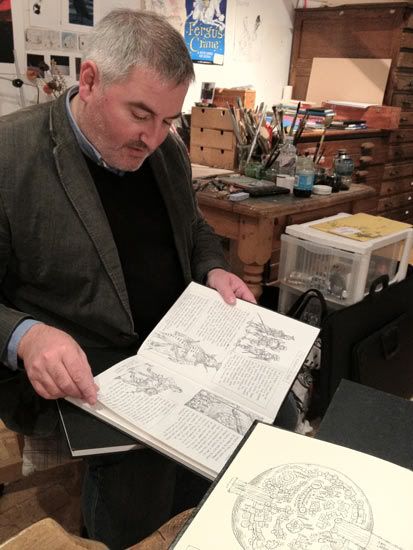
You can follow Chris on Twitter (@chrisriddell50) and Instagram.
Blog: Sarah McIntyre (Login to Add to MyJacketFlap)
JacketFlap tags: scbwi, pictures_mean_business, Add a tag
Hurrah for The Bookseller magazine, for not getting sore when a bunch of us criticised it for not properly listing illustrators in articles and sales charts. Instead, they've listened, made changes, and this week opened up wider debate on the #PicturesMeanBusiness issue. Journalist Charlotte Eyre asked me to write this piece for today's issue (which you can also read online here). 
Portrait photo in The Bookseller by Dave Warren
Charlotte has written a longer piece, and created a 'Top 10 Picture Book Illustrators' sales chart, which is something very new. Helen Oxenbury has gone from being unmentioned for her role in creating We're Going on a Bear Hunt with Michael Rosen to being listed in her own right as illustrator. You can read Charlotte's article here, Nielsen calls for debate over crediting illustrators. 
But the issue's not as clear as we illustrators would like to think, and Charlotte flags some of the complex areas which need addressing: 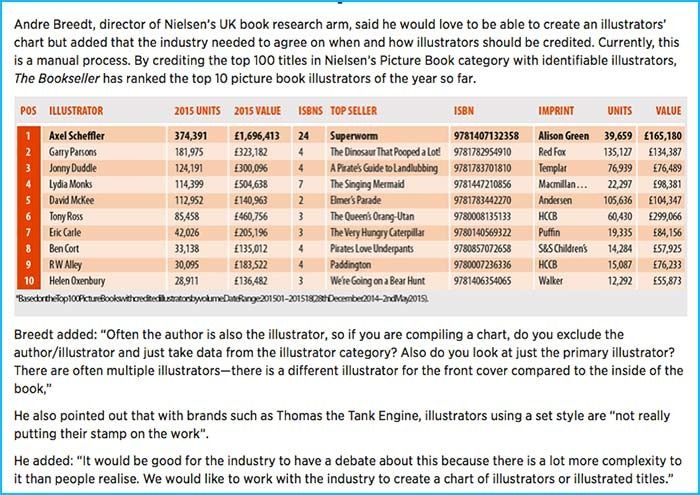
Last Wednesday, a group of us from the Society of Children's Book Writers & Illustrators met in the Savoy Tup pub in London to discuss #PicturesMeanBusiness, organised by active SCBWI members Candy Gourlay and Mo O'Hara. Carnegie head Joy Court, Charlotte Eyre and I talked with the group about the campaign and we pooled what knowledge people in the room had on the issue so far.
Joy was the first person who made me aware that the data was such a big issue in the Carnegie award listings. One thing I've been learning, and which was strengthened by the discussion was that Nielsen isn't entirely to blame for the problem. When I first came to the issue, it seemed like the main problem was that Nielsen had outdated software and needed to update it; then all the listings would fall into place. But that's only partly true. The other problem is that publishers all have different ways of organising the data they submit to Nielsen (many of their own systems desperately outdate), and Nielsen has to work with what it's given.
Some publishers realise that their illustrators may not get credit if they list them as illustrators, so they list them as authors. (And, in a sense, illustrators are authors in telling the story.) But if they leave the illustrator field blank, then it's tricky to discover who illustrated the book. Other publishers are giving incomplete data, possibly only listing the writer. What's submitted to Nielsen is a big, irregular mish-mash. Since the publishers are paying Nielsen for the data collection service, it's more likely that they can demand things of Nielsen, rather than Nielsen demanding software upgrades from the publishers. Charlotte has been liasing with a contact at Nielsen and said he's been very open and helpful about it.
So we need to look to the publishers to provide more regular data. Digital data may be a boring topic, but it is a BIG DEAL. As more and more processes are computerised, our livelihoods become very dependent on the accuracy and searchability of this data. Amazon are leading the way in organising their data, and because it's so easy to find things on their websites, it's beating out sellers who don't have access to such good data. UK publishers need to up their games so Amazon doesn't take all the sales. (And politicians need to sort out better tax laws so sellers are taxed fairly and equally, but that's another subject, even if it's related.)
At the SCBWI discussion, we asked, how can we encourage publishers provide better data? One suggestion by Charlotte was to try to get publishers to sign up to a charter, agreeing on a standard way of submitting book data. By signing, they would be stating that they submitted a complete set of data to the charter's specified standards (including illustrators and translators). Charlotte said The Bookseller might be able to spearhead this action.
But as Charlotte has pointed out in her article today, crediting is not always clear. We're going to talk more about this in a follow-up discussion on Twitter at 4pm (British time) on the hash tag #FutureChat. Bookseller Associate Editor Porter Anderson will be hosting the discussion, manning @TheFutureBook account. Please do take part if you can! 
And I've realised that my #PicturesMeanBusiness updates sprawl over many blog posts, so I've tightened them up on to one page here: www.jabberworks.co.uk/pictures-mean-business
On that page I talk about:
1. The problem of uncredited illustrators
2. Why it matter and whom it affects (beyond illustrators)
2. How you can help with the campaign
4. Campaign progress so far
And I just spotted that Bookseller Associate Editor Porter Anderson has blogged about WRITERS going uncredited! I can see what he means: there is a lot of 'The Times says...' or 'The Bookseller claims that...' without mentioning the journalist.
Big thanks to writers Candy and Mo for hosting this weeks' SCBWI event! 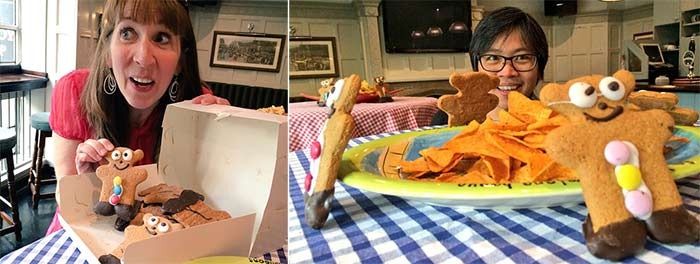
One wonderful thing from that night was meeting Yat-Hong Chow, who created this book, Yellow as a real family effort. His seven-year-old son, Yü Chow, wrote the text, 'a fictional diary of a seven year old boy', with his dad's help. Yat designed the book, and his wife, Yü's mother, Hannah Kops, created the illustrations. Not every family can do this so expertly, but it's a wonderful example of a family coming together and recognising every aspect of creating a book. What a sense of achievement, to work as a team and create something like that together! (Here's their Kickstarter page.) It felt very much in the spirit of what we'd been discussing that evening. 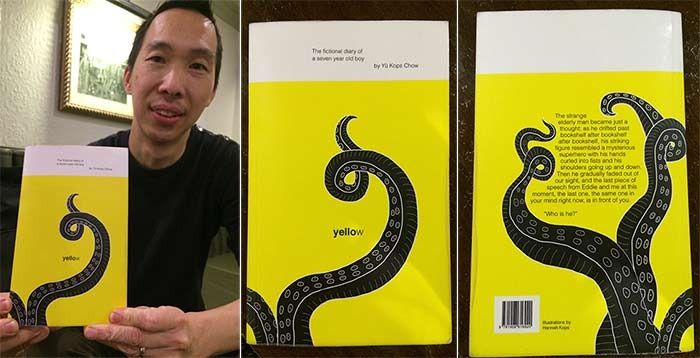
Blog: Sarah McIntyre (Login to Add to MyJacketFlap)
JacketFlap tags: pictures_mean_business, Add a tag
Hey guys, journalist Charlotte Eyre and I have both written pieces on the #PicturesMeanBusiness topic for a spread in Friday's magazine, and Associate Editor Porter Anderson is going to be hosting a discussion at 4pm on the #FutureChat hash tag. If you're interested in this and are on Twitter, it would be great if you could take part!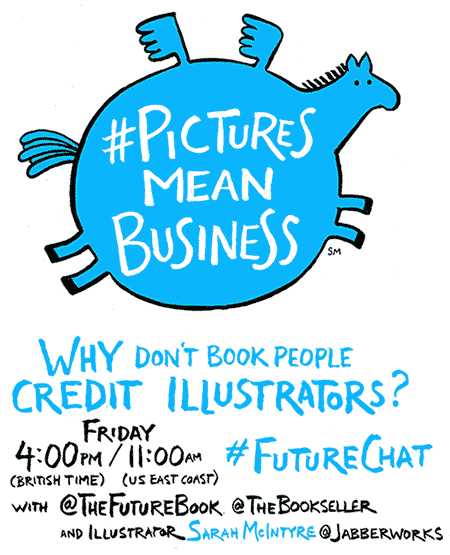
Blog: Sarah McIntyre (Login to Add to MyJacketFlap)
JacketFlap tags: pictures_mean_business, Add a tag
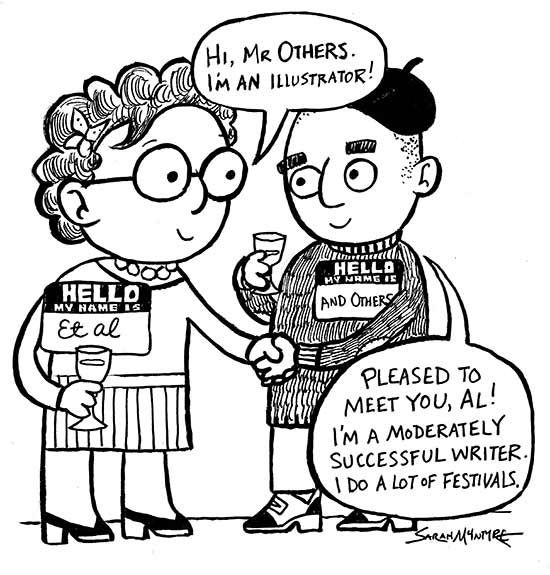
Good things are happening, but we still have a ways to go.... 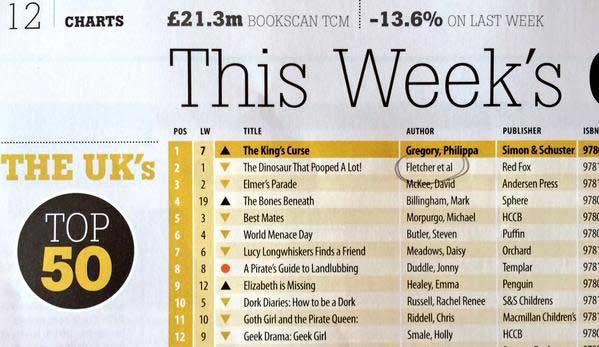
Charts in this week's copy of The Bookseller
Click here for earlier #PicturesMeanBusiness articles.
Blog: Sarah McIntyre (Login to Add to MyJacketFlap)
JacketFlap tags: pictures_mean_business, Add a tag
At last, it's happened! The Bookseller trade magazine, from this week, is listing writers AND illustrators in the sales rankings for illustrated books! Hooray!!! This might look like a small thing, but it's a good start to being taken seriously as professionals who contribute to book sales.
Big thanks to journalist Charlotte Eyre and editor Philip Jones for making this happen. See here, you can spot Tony Ross, Garry Parsons and Axel Scheffler, who wouldn't have been listed as of last week: 
If you take a look at their covers, you can immediately see these books aren't just words and paper; so much of what makes them is the illustrations: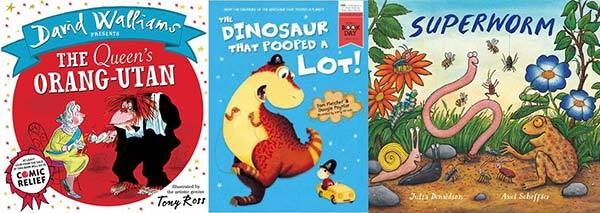
Huge thanks to everyone who's been supporting the #PicturesMeanBusiness campaign! Even when we've pointed things out, people have been incredibly helpful and made changes; there's no lack of goodwill, it's just sometimes people haven't noticed illustrators being left out. So what's happened so far?
What have we definitely achieved?
1. Carnegie listing: illustrators were included on the Carnegie medal longlist.
Writers were always listed on the Greenaway lists, even though it's an illustration award, and the listings had followed a long-standing format, using incomplete data supplied by Nielsen. (Philip Reeve has always freely credited me as a co-author for Oliver and the Seawigs so our own listing there was obviously incorrect. He's blogged about it here.) The committee still need to consider how illustrations play a part in judging these books, and if they can accept co-authored books in future lists.
2. An online and printed apology from The Bookseller for feature article celebrating writer Michael Rosen as the creator of the We're Going on a Bear Hunt picture book with no mention of illustrator Helen Oxenbury.
This kind of omission has been common in the media generally and hopefully we'll be seeing less of it. But The Bookseller is a trade magazine, and we really need our own book people to be pioneers in this - bloggers, publishers, parents, teachers, people who already love illustrated books.
3. The Book People amended the listings of winners on the website for the Red House Children's Book Awards to include illustrator Oliver Jeffers in the award for The Day the Crayons Quit.
Only writer Drew Daywalt had been credited, although apparently Jeffers was also credited in the printed press release. The website manager still hasn't fixed the listings for the other nominees. The Book People's Twitter spokesperson explained that they gathered their own data, but the website didn't allow enough characters on the line to include two names (so at least one co-author was also left out). The spokesperson said it might take awhile to fix this but they'd get on the case.
4. The Reading Agency amended their Summer Reading Challenge Record Breakers book collections online lists to include illustrators.
They had included some illustrators but not all, and they explained that their data came from the publishers. Kudos to them, they were very quick to fix this, and thanks to writer Caryl Hart for leading the way on this one.
5. The Bookseller magazine has begun listing illustrators in sales charts.
What still needs to happen?
1. The big book databases are still faulty.
These subscription-financed companies are still pumping out book information to many different sources that doesn't include the name of the illustrator (or often the translator). This is partly because their systems are badly in need of upgrading and partly because publishers still aren't filling in all the relevant 'meta data' when they register their books. Here's what's happening so far:
* Journalist at The Bookseller Charlotte Eyre and my agent, Jodie Hodges, are looking into this so they can go right to the companies with well-researched questions. So let them know if you have any good information or insights on the subject. I'm like most illustrators, I know something's wrong but I still don't know exactly what, because I don't have access to any of these subscription-only databases.
* Publishers, we're asking you: please, please be sure to fill in at least the names of your writers, illustrators and translators. And it would be great if you could include illustrator names on the front covers of illustrated books, to make the illustrator name easier to spot.
2. The wider media still needs to realise illustrators have a major role in creating picture books.
I don't want this to become a sort of witch hunt for people who accidentally leave out illustrators, but when, say, The Guardian does a features specifically about picture books, it seems nuts not to include the illustrators. Here's an example from World Book Day. The girl in the picture has made a terrific Superworm costume, based on the book by writer Julia Donaldson and illustrator Axel Scheffler. The costume is a based on Axel's paintings of Superworm, but the journalist credits the book as 'Superworm by Julia Donaldson'. Even the parent is more clued in, recognising the 'Axel Scheffler style eyes', but Axel's name should really be in the book credits. Let's let children (and their parents) be inspired by illustrators as well as writers.
3. Teachers need reminded of the importance of illustration.
My Superkid co-author, writer Claire Freedman, supportively retweeted my bafflement at this World Book Day classroom poster. I love the enthusiasm of the teacher who made it, but since the whole poster is based on the visuals of Superkid, why has he or she only included Claire's name? (Claire didn't decide how Superkid was going to look.) 
Teachers are missing a trick, if they're not teaching their kids that there's more than one role in creating a picture book, and that stories can be told through both writing AND drawing. Some people get into stories through words, some through pictures, and most through a combination of both. And drawing can be a way in to storytelling for many children. People who train teachers, if you could flag this to them, that would be wonderful.
4. ACLS payments.
To be honest, I don't know anything about this yet, but writer-illustrator Debi Gliori has flagged it:
The ALCS site only has categories for author, co-author, contributor etc on its site when one is entering books to be included for future royalty payments. When I coauthored or in other words illustrated a few books, it deemed my contribution to be 0% and credited me accordingly. That needs fixed too.
Does anyone want to get on the case with this one?
Again, thanks for your support, and if you could keep using the #PicturesMeanBusiness hash tag, that would be great! (Click here for past blog articles on the topic.) This affects everyone, not just illustrators. We'll get better illustrated books if people can do it for a living.
Blog: Sarah McIntyre (Login to Add to MyJacketFlap)
JacketFlap tags: pictures_mean_business, Add a tag
So here's my latest update on the #PicturesMeanBusiness campaign. Like most illustrators, I still don't know very much about why we regularly get left out of being credited for the books we illustrate, but I'm discovering more and more that it's not a complete lack of respect from people in the publishing industry. It all keeps coming back to two things:
1. Tediously faulty data systems, or 'meta data'
2. People who don't think to question this faulty data
That's why we had an article in The Bookseller quoting Axel Scheffler feeling undervalued for his work, right above a listing where he's not mentioned with the picture book he illustrated (Superworm). It wasn't deliberate, someone just didn't put two-and-two together: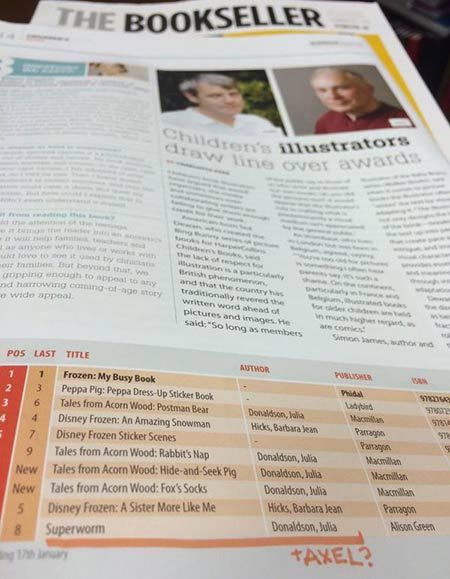
It happened again today: the Red House Children's Book Awards were announced and when I clicked over to their award page of their website, only the writers of the books were listed. Which is odd, because you can see a little picture of illustrator Oliver Jeffers on their home page. So they were obviously thinking about him, they just forgot to put his name into the listing. 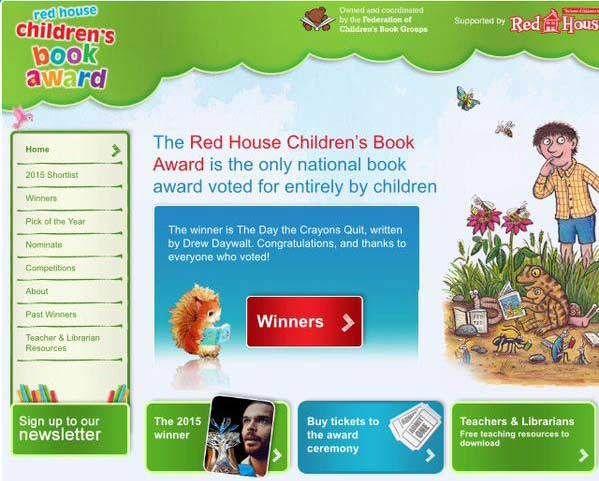
Now anyone who looks at Drew and Oliver's book sees it's highly dependent on illustrations and Oliver's hand-drawn lettering. And you may think, does this even matter? Everyone knows Oliver illustrated that book. ...Well, yes, it does. That press release will have gone out to the media and there's a good chance many of them will plug the data into their articles without even checking to see the illustrator's been left out. Illustrators rely heavily on brand identity for ongoing sales, and this doesn't help.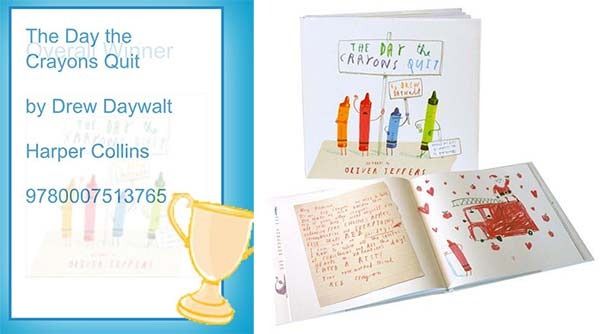
I (rather nervously) brought it up with the award's hosts, The Book People, on Twitter, and they're like most of us, they're people who love books and want to get things right, they're just rushing a bit and don't have the latest software. 
It wasn't just illustrators; even a co-writer (Amanda Swift) got left out because they couldn't fit two names on the date entry line.
But the whole point of these awards is publicity and raising the profile of children's books, so it would make sense for awards people to stop and think how they're presenting this information ('after careful consideration') to the public. I'm sure the judges put a lot of thought into the selection, and the website people are separate from the judging process, but it makes the awards look slapdash, like the people involved haven't actually sat down and looked at the physical books, to notice that they're illustrated. I'm sure this isn't true, but it's not a clever way to present the public face of the award.
I was happy to see a few hours later that the website had already been updated to include Oliver's name. Hurrah! So it IS possible, it's not too much of a programming nightmare. But there are several other illustrators who need added - David Tazzyman (illustrator of Demon Dentist), Thomas Flintham (Baby Aliens Got my Teacher), and Bruce Ingman (Let Loose the Leopard). And throughout the website, there are lots of other illustrators left unlisted (for example, David Tazzyman and Sarah Horne in their Pick of the Year list). Here's the fixed entry: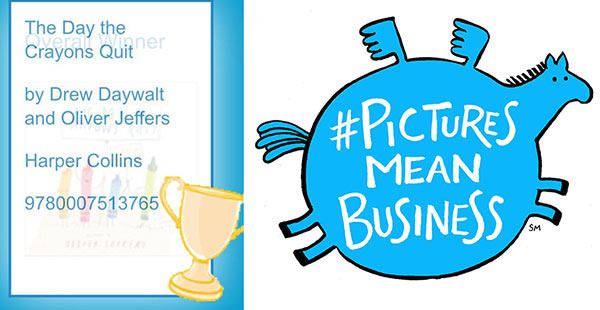
Kudos to the rep at The Book People for replying so quickly and starting to get on the case! I realise they honestly do mean well. 
But it's a call for people to think when they get book data. I'm hoping very much we can fix some of the most cumbersome systems (Nielsen - and Biblio/Virtusales, which I only just heard about) and encourage publishers enter all the right information. (Good ol' Nosy Crow...)
But until then, publishing world and media, if you love book illustration, please stand by us and fix this faulty data manually.
Keep an eye on the hash tag and add your comments: #PicturesMeanBusiness
. . .
NOOOOOOOO!!!! Just as a saved this blog post, I saw a tweet from wonderful writer Caryl Hart. And I love The Reading Agency, they hosted me as last year's Summer Reading Challenge illustrator, but guess what, they've forgotten to credit a lot of illustrators on their book list. And again, it's most likely a data problem. And people not paying attention. ARGHHHHHHH. Please, someone just make it stop...!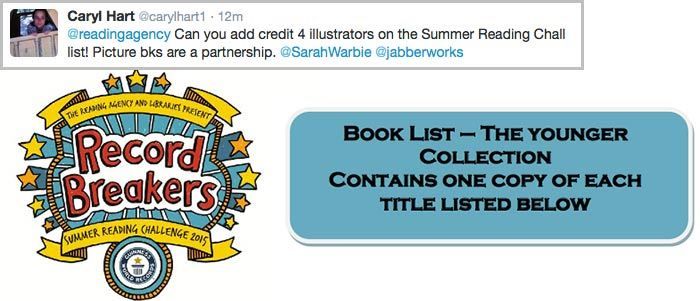
(See the picture book list here.)


